Paul van Yperen's Blog, page 125
May 18, 2022
Soviet film postcards of the 1920s
During the 1920s, the cinema of the Soviet Union was at its best. But who were the actors in these films? Vintage postcards of the Soviet cinema of the 1920s are rare. But in 1927, a new postcard series was introduced by Goznak in Moscow, which presented both pictures of Russian actors and of the stars of the silent European cinema and Hollywood.
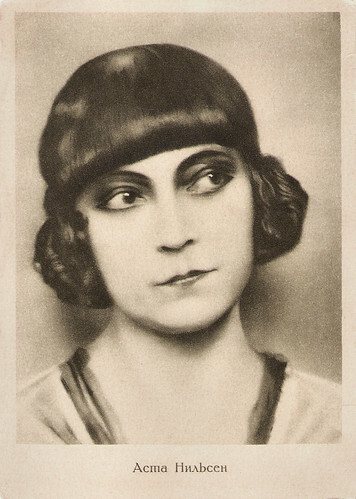
Russian postcard by Goziak, Moscow, series, no. 2, no. A-1725, 1927. The card was issued in an edition of 15,000 copies.
Danish silent film actress Asta Nielsen (1881-1972), was one of the most popular leading ladies of the 1910s and one of the first international film stars. Of her 74 films between 1910 and 1932, seventy were made in Germany where she was known simply as 'Die Asta'. Noted for her large dark eyes, mask-like face, and boyish figure, Nielsen most often portrayed strong-willed passionate women trapped by tragic consequences.
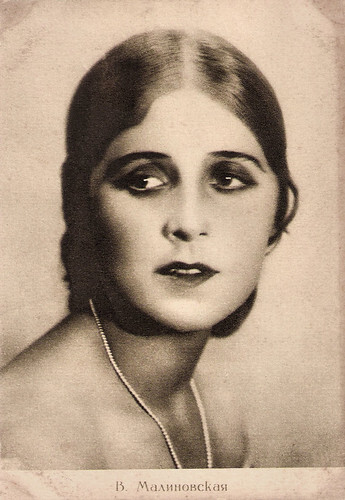
Russian postcard by Goziak, Moscow, series no. 4, no. A-2400, 1927. Published in an edition of 25,000 cards.
Vera Malinovskaya (1900-1988), also written as Malinovskaja or Malinovskaia, played in several Russian films of the 1920s and also in a few films in Germany and Austria. From 1925 on, she had leading roles in films by the Mezhrabpom film company, often playing innocent girls. In 1925 she played Dunia opposite Ivan Moskvin in Kollezhskiy registrator/The Station Master (Ivan Moskvin, Yuri Zhelyabuzhsky, 1925), scripted by Fyodor Otsep (Fedor Ozep), after a novel by Alexander Pushkin.
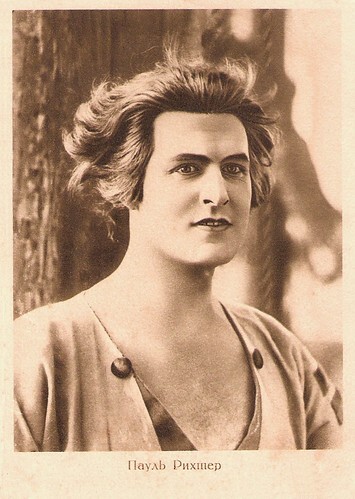
Russian postcard by Goziak, Moscow. Paul Richter in Pietro der Korsar/Peter the Pirate (Arthur Robison, 1925).
Austrian actor Paul Richter (1895-1961) starred in several silent films directed by Joe May and Fritz Lang. He became an idol of the 1920s with the lushly produced Ufa production Die Nibelungen (Fritz Lang, 1924).
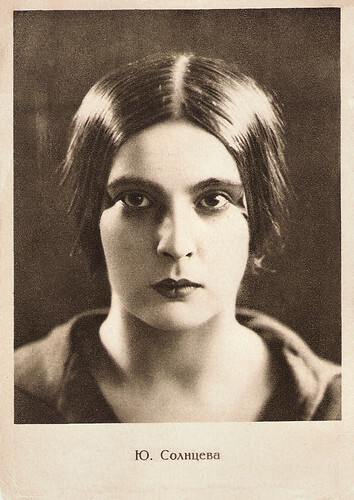
Russian postcard by Goziak, Moscow, no. 2, 1927.
Yuliya Solntseva (1901–1989) was a Soviet film director and actress who starred as the Queen of Mars in the silent Sci-Fi classic Aelita (Yakov Protazanov, 1924) and as a cigarette girl in the romantic comedy Papirosnitsa ot Mosselproma/The Cigarette Girl of Mosselprom (Yuri Zhelyabuzhsky, 1924). Solntseva directed 14 films between 1939 and 1979. She was married to director Aleksandr Dovzhenko and collaborated with him on his later films, including Michurin (1949), for which she was awarded a Stalin Prize. For Povest plamennykh let/The Chronicle of Flaming Years (1961), she won the Best Director award at the 1961 Cannes Film Festival. She was named a People's Artist of the USSR when she turned 80.
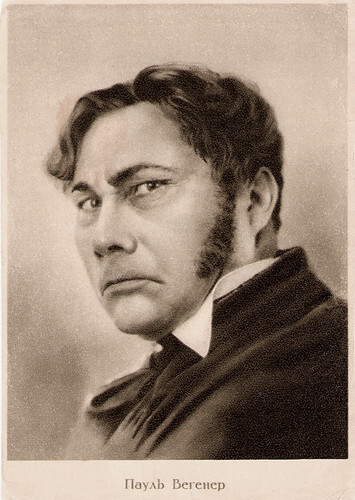
Russian postcard, no. 4, 1927.
German actor, writer, and film director Paul Wegener (1874-1948) is one of the true fathers of the horror and fantasy genre, particularly remembered for his three silent films centred around the Jewish legend of the Golem. Wegener was one of the pioneers of German cinema who realised the potential of the new medium and used the possibilities of cinematic trick photography as a method for presenting fantastic tales in a serious matter.
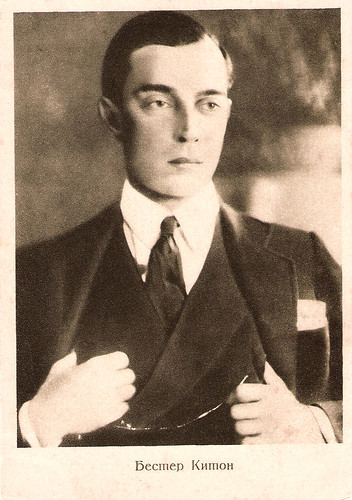
Russian postcard by Goziak, Moscow, no. 1725, 1927.
Stone-faced Buster Keaton (1895-1966) was one of the three greatest comedians of Silent Hollywood. His most enduring features include Our Hospitality (1923), The Navigator (1924), Sherlock Jr. (1924), College (1927), and The General (1927).
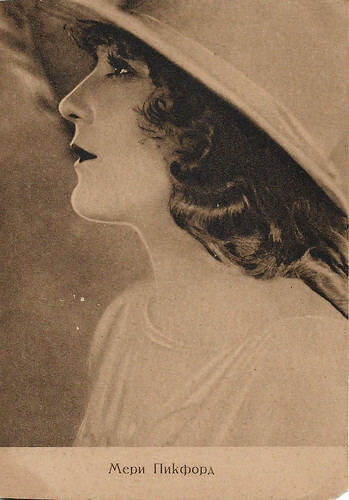
Russian postcard by Goziak, Moscow, no. A-11967, 1928. The card was issued in an edition of 25,000 copies.
Mary Pickford (1892-1979) was a legendary silent film actress and was known as 'America’s sweetheart'. She married Douglas Fairbanks, Sr. in 1920, becoming one of Hollywood’s earliest super couples. Fans adored the pairing, and the couple was mobbed at every port on their whirlwind European honeymoon. She scored box-office hits with Polyanna (1920), Little Lord Fauntleroy (1921), and Tess of the Storm Country (1922). She was a founder of United Artists and helped to establish the Academy.
The ideological and artistic needs of the proletariat
In 1924, filmmakers Sergei Eisenstein and Lev Kuleshov created the first association of Soviet filmmakers, the Association of Revolutionary Cinematography (ARK), to “meet the ideological and artistic needs of the proletariat”. Although state-controlled, the organisation was characterised by a pluralism of political and artistic views until the late 1920s.
One of the most iconic developments in film during this period that is still used in films today was editing and montage to create meaning. This style of filmmaking came to be known as 'the Kuleshov effect' and was employed to conserve film stock due to shortages during that period.
Innovation in Russian filmmaking was expressed particularly in the work of Eisenstein such as his films Bronenosets Potyomkin/Battleship Potemkin (1925) and Oktyabr': Desyat' dney kotorye potryasli mir/October: Ten Days That Shook the World (1928).
Also noteworthy was Vsevolod Pudovkin's adaptation of Maxim Gorky's Mat/Mother to the screen in 1926. Pudovkin developed themes of revolutionary history in the film Konets Sankt-Peterburga/The End of St. Petersburg (1927).
Other noteworthy silent films were films dealing with contemporary life such as Boris Barnet's Dom na Trubnoy/The House on Trubnaya (1928). The films of Yakov Protazanov were devoted to the revolutionary struggle and the shaping of a new way of life, such as Don Diego i Pelageya/Don Diego and Pelagia (1928).
And finally, the Ukrainian director Aleksandr Dovzhenko was noteworthy for the historical-revolutionary epic Arsenal (1929) and the poetic film Zemlya/Earth (1930).
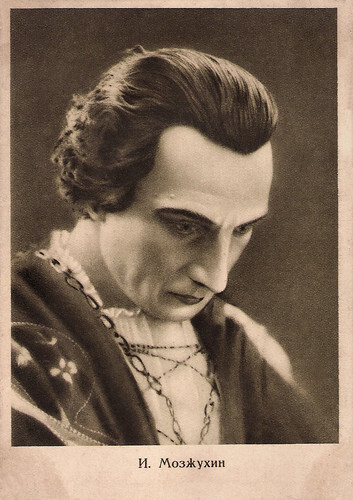
Russian postcard by Goziak, Moscow, series no. 5, no. A 4711, 1928. The card was issued in an edition of 25,000 copies. The price was 10 Kop. Photo: Ivan Mozzhukhin in Kean/Edmund Kean: Prince Among Lovers (Alexandre Volkoff, 1924).
Russian actor Ivan Mozzhukhin (1889-1939) was a legendary star of the European silent film. He escaped from execution by the Soviet Red Army and made a stellar career in Europe, but he suffered in Hollywood. He first starred in about thirty silent Russian films made by Pyotr Chardynin, Aleksandr Khanzhonkov, and Yevgeni Bauer. From 1915 to 1919 he worked in about 40 films by directors Yakov Protazanov and Viktor Tourjansky under the legendary Russian producer Joseph N. Ermolieff. After the Revolution, in 1920, he left Russia together with his wife Nathalie Lissenko and his partners from Ermolieff. They emigrated together to France and started in Paris a Russian-French film company. He starred in hits like the innovative murder mystery La maison du mystère/The Mysterious House (1923), Kean/Edmund Kean: Prince Among Lovers (1924), and the lavish adventure spectacle Michel Strogoff/Michael Strogoff (1926) based on the Jules Verne novel. Best remembered is the humourous and visually splendid epic Casanova/The Loves of Casanova (1927).
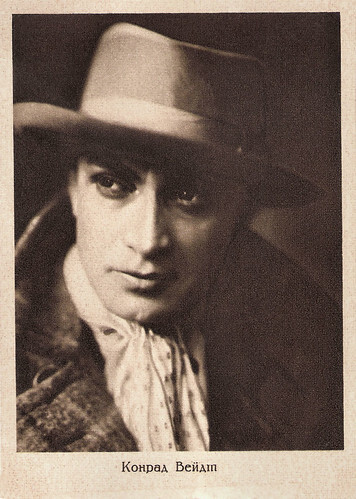
Russian postcard, no. 6, 1928.
Conrad Veidt (1893–1943) was the most highly strung and romantically handsome of the German expressionist actors. From 1916 until his death, he appeared in well over 100 films, including such classics as Das Kabinett des Dr. Caligari/Das Cabinet des Dr. Caligari (Robert Wiene, 1920) and Casablanca (Michael Curtiz, 1942).
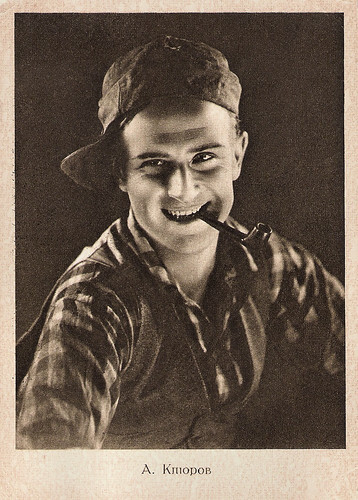
Russian postcard by Goziak, Moscow, series no. 9, no. A-15639, 1928. The card was issued in an edition of 10,000 copies. The price was 10 Kop.
Anatoli Ktorov (1898-1980) was a brilliant Soviet and Russian film and stage actor who was stuttering in real life but was perfectly eloquent in acting roles. He had a career spanning from silent films Yakov Protazanov to the Oscar-winning epic Voyna i mir/War and Peace (1965-1967). He became a People's Artist of the USSR in 1963.
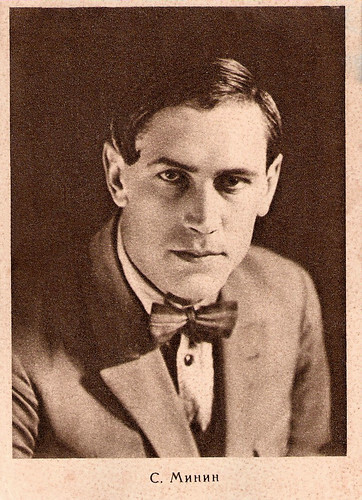
Russian postcard by Goziak, Moscow, series no. 8, no. A-16279, 1928. The card was issued in an edition of 30,000 copies. The price was 10 Kop.
Russian actor Sergei Minin (1901-1937) was a star of the Soviet cinema of the 1920s. He worked with such famous directors as Abram Room and Ilya Trauberg.
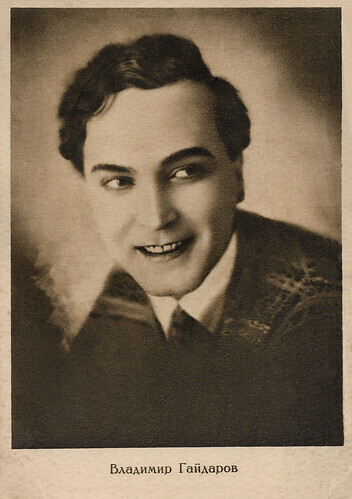
Russian postcard by Goziak, Moscow, series no. 5, no. A-47112, 1928. The card was issued in an edition of 25,000 copies. The price was 10 Kop.
Ukrainian actor Vladimir Gajdarov (1893-1976) (aka Wladimir Gaidarow and Vladimir Gaidaroff) was a popular star in the European silent cinema. He began his film career in Russia before the October Revolution. Later he became a popular star in the German and French silent cinema. The sound film made him return to his home country, but in the Soviet Union, he had a hard time getting work.
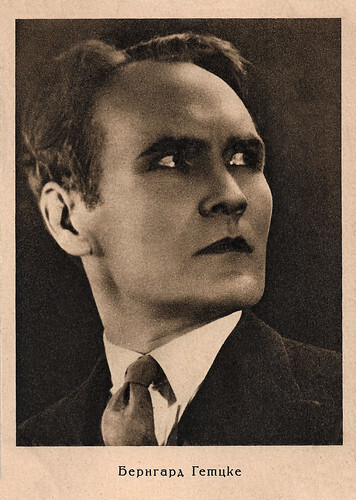
Russian postcard by Goziak, Moscow, series no. 14, no. A 29871, 1929. The card was issued in an edition of 15,000 copies. The price was 10 Kop.
German film actor Bernhard Goetzke (1884-1964) was one of the impressive stars of the silent films by Fritz Lang. He appeared in 130 films between 1917 and 1961.
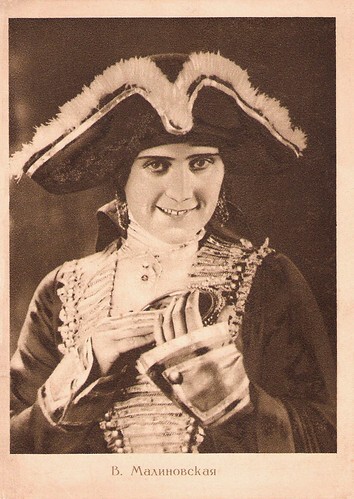
Russian postcard by Goziak, Moscow.
Vera Malinovskaya (1900-1988), also written as Malinovskaja/Malinovskaia, played in several Russian films of the 1920s and a few in Germany and Austria.
Sources: Wikipedia and .

Russian postcard by Goziak, Moscow, series, no. 2, no. A-1725, 1927. The card was issued in an edition of 15,000 copies.
Danish silent film actress Asta Nielsen (1881-1972), was one of the most popular leading ladies of the 1910s and one of the first international film stars. Of her 74 films between 1910 and 1932, seventy were made in Germany where she was known simply as 'Die Asta'. Noted for her large dark eyes, mask-like face, and boyish figure, Nielsen most often portrayed strong-willed passionate women trapped by tragic consequences.

Russian postcard by Goziak, Moscow, series no. 4, no. A-2400, 1927. Published in an edition of 25,000 cards.
Vera Malinovskaya (1900-1988), also written as Malinovskaja or Malinovskaia, played in several Russian films of the 1920s and also in a few films in Germany and Austria. From 1925 on, she had leading roles in films by the Mezhrabpom film company, often playing innocent girls. In 1925 she played Dunia opposite Ivan Moskvin in Kollezhskiy registrator/The Station Master (Ivan Moskvin, Yuri Zhelyabuzhsky, 1925), scripted by Fyodor Otsep (Fedor Ozep), after a novel by Alexander Pushkin.

Russian postcard by Goziak, Moscow. Paul Richter in Pietro der Korsar/Peter the Pirate (Arthur Robison, 1925).
Austrian actor Paul Richter (1895-1961) starred in several silent films directed by Joe May and Fritz Lang. He became an idol of the 1920s with the lushly produced Ufa production Die Nibelungen (Fritz Lang, 1924).

Russian postcard by Goziak, Moscow, no. 2, 1927.
Yuliya Solntseva (1901–1989) was a Soviet film director and actress who starred as the Queen of Mars in the silent Sci-Fi classic Aelita (Yakov Protazanov, 1924) and as a cigarette girl in the romantic comedy Papirosnitsa ot Mosselproma/The Cigarette Girl of Mosselprom (Yuri Zhelyabuzhsky, 1924). Solntseva directed 14 films between 1939 and 1979. She was married to director Aleksandr Dovzhenko and collaborated with him on his later films, including Michurin (1949), for which she was awarded a Stalin Prize. For Povest plamennykh let/The Chronicle of Flaming Years (1961), she won the Best Director award at the 1961 Cannes Film Festival. She was named a People's Artist of the USSR when she turned 80.

Russian postcard, no. 4, 1927.
German actor, writer, and film director Paul Wegener (1874-1948) is one of the true fathers of the horror and fantasy genre, particularly remembered for his three silent films centred around the Jewish legend of the Golem. Wegener was one of the pioneers of German cinema who realised the potential of the new medium and used the possibilities of cinematic trick photography as a method for presenting fantastic tales in a serious matter.

Russian postcard by Goziak, Moscow, no. 1725, 1927.
Stone-faced Buster Keaton (1895-1966) was one of the three greatest comedians of Silent Hollywood. His most enduring features include Our Hospitality (1923), The Navigator (1924), Sherlock Jr. (1924), College (1927), and The General (1927).

Russian postcard by Goziak, Moscow, no. A-11967, 1928. The card was issued in an edition of 25,000 copies.
Mary Pickford (1892-1979) was a legendary silent film actress and was known as 'America’s sweetheart'. She married Douglas Fairbanks, Sr. in 1920, becoming one of Hollywood’s earliest super couples. Fans adored the pairing, and the couple was mobbed at every port on their whirlwind European honeymoon. She scored box-office hits with Polyanna (1920), Little Lord Fauntleroy (1921), and Tess of the Storm Country (1922). She was a founder of United Artists and helped to establish the Academy.
The ideological and artistic needs of the proletariat
In 1924, filmmakers Sergei Eisenstein and Lev Kuleshov created the first association of Soviet filmmakers, the Association of Revolutionary Cinematography (ARK), to “meet the ideological and artistic needs of the proletariat”. Although state-controlled, the organisation was characterised by a pluralism of political and artistic views until the late 1920s.
One of the most iconic developments in film during this period that is still used in films today was editing and montage to create meaning. This style of filmmaking came to be known as 'the Kuleshov effect' and was employed to conserve film stock due to shortages during that period.
Innovation in Russian filmmaking was expressed particularly in the work of Eisenstein such as his films Bronenosets Potyomkin/Battleship Potemkin (1925) and Oktyabr': Desyat' dney kotorye potryasli mir/October: Ten Days That Shook the World (1928).
Also noteworthy was Vsevolod Pudovkin's adaptation of Maxim Gorky's Mat/Mother to the screen in 1926. Pudovkin developed themes of revolutionary history in the film Konets Sankt-Peterburga/The End of St. Petersburg (1927).
Other noteworthy silent films were films dealing with contemporary life such as Boris Barnet's Dom na Trubnoy/The House on Trubnaya (1928). The films of Yakov Protazanov were devoted to the revolutionary struggle and the shaping of a new way of life, such as Don Diego i Pelageya/Don Diego and Pelagia (1928).
And finally, the Ukrainian director Aleksandr Dovzhenko was noteworthy for the historical-revolutionary epic Arsenal (1929) and the poetic film Zemlya/Earth (1930).

Russian postcard by Goziak, Moscow, series no. 5, no. A 4711, 1928. The card was issued in an edition of 25,000 copies. The price was 10 Kop. Photo: Ivan Mozzhukhin in Kean/Edmund Kean: Prince Among Lovers (Alexandre Volkoff, 1924).
Russian actor Ivan Mozzhukhin (1889-1939) was a legendary star of the European silent film. He escaped from execution by the Soviet Red Army and made a stellar career in Europe, but he suffered in Hollywood. He first starred in about thirty silent Russian films made by Pyotr Chardynin, Aleksandr Khanzhonkov, and Yevgeni Bauer. From 1915 to 1919 he worked in about 40 films by directors Yakov Protazanov and Viktor Tourjansky under the legendary Russian producer Joseph N. Ermolieff. After the Revolution, in 1920, he left Russia together with his wife Nathalie Lissenko and his partners from Ermolieff. They emigrated together to France and started in Paris a Russian-French film company. He starred in hits like the innovative murder mystery La maison du mystère/The Mysterious House (1923), Kean/Edmund Kean: Prince Among Lovers (1924), and the lavish adventure spectacle Michel Strogoff/Michael Strogoff (1926) based on the Jules Verne novel. Best remembered is the humourous and visually splendid epic Casanova/The Loves of Casanova (1927).

Russian postcard, no. 6, 1928.
Conrad Veidt (1893–1943) was the most highly strung and romantically handsome of the German expressionist actors. From 1916 until his death, he appeared in well over 100 films, including such classics as Das Kabinett des Dr. Caligari/Das Cabinet des Dr. Caligari (Robert Wiene, 1920) and Casablanca (Michael Curtiz, 1942).

Russian postcard by Goziak, Moscow, series no. 9, no. A-15639, 1928. The card was issued in an edition of 10,000 copies. The price was 10 Kop.
Anatoli Ktorov (1898-1980) was a brilliant Soviet and Russian film and stage actor who was stuttering in real life but was perfectly eloquent in acting roles. He had a career spanning from silent films Yakov Protazanov to the Oscar-winning epic Voyna i mir/War and Peace (1965-1967). He became a People's Artist of the USSR in 1963.

Russian postcard by Goziak, Moscow, series no. 8, no. A-16279, 1928. The card was issued in an edition of 30,000 copies. The price was 10 Kop.
Russian actor Sergei Minin (1901-1937) was a star of the Soviet cinema of the 1920s. He worked with such famous directors as Abram Room and Ilya Trauberg.

Russian postcard by Goziak, Moscow, series no. 5, no. A-47112, 1928. The card was issued in an edition of 25,000 copies. The price was 10 Kop.
Ukrainian actor Vladimir Gajdarov (1893-1976) (aka Wladimir Gaidarow and Vladimir Gaidaroff) was a popular star in the European silent cinema. He began his film career in Russia before the October Revolution. Later he became a popular star in the German and French silent cinema. The sound film made him return to his home country, but in the Soviet Union, he had a hard time getting work.

Russian postcard by Goziak, Moscow, series no. 14, no. A 29871, 1929. The card was issued in an edition of 15,000 copies. The price was 10 Kop.
German film actor Bernhard Goetzke (1884-1964) was one of the impressive stars of the silent films by Fritz Lang. He appeared in 130 films between 1917 and 1961.

Russian postcard by Goziak, Moscow.
Vera Malinovskaya (1900-1988), also written as Malinovskaja/Malinovskaia, played in several Russian films of the 1920s and a few in Germany and Austria.
Sources: Wikipedia and .
Published on May 18, 2022 22:00
May 17, 2022
A Home at the End of the World (2004)
A Home at the End of the World (Michael Mayer, 2004) is a lyrical American drama from a screenplay by Michael Cunningham, based on Cunningham's 1990 novel of the same name. It stars Colin Farrell, Robin Wright Penn, Dallas Roberts, and Sissy Spacek.
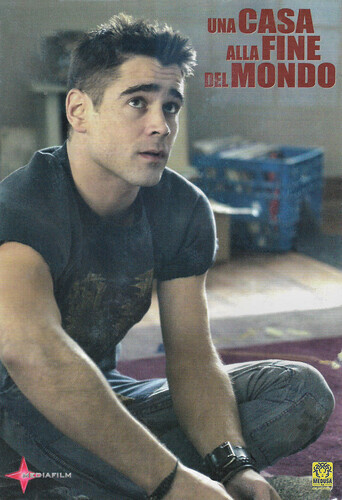
Italian postcard by Media Film, Milano. Photo: Media Film / Medusa. Colin Farrell in A Home at the End of the World (Michael Mayer, 2004).
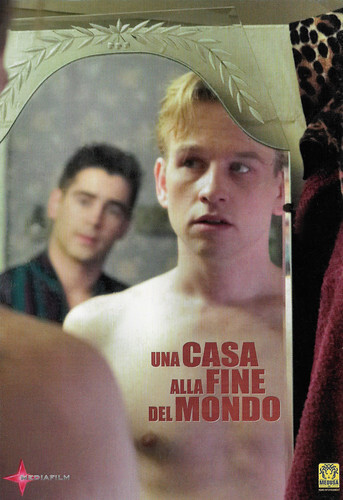
Italian postcard by Media Film, Milano. Photo: Media Film / Medusa. Dallas Roberts and Colin Farrell in A Home at the End of the World (Michael Mayer, 2004).
A journey of trials, triumphs, loves, and losses
A Home at the End of the World (Michael Mayer, 2004) is based on a novel by Michael Cunningham, the Pulitzer Prize-winning author of 'The Hours'. The film chronicles a dozen years in the lives of two best friends who couldn't be more different.
We follow them from suburban Cleveland in the 1960s to New York City in the 1980s. Bobby Morrow's (Colin Farrell) life has been tinged with tragedy since he was a young boy, losing first his beloved older brother to a freak accident, then his mother to illness, and finally his father.
As a rebellious teenager, he meets the conservative and gawky Jonathan Glover (Dallas Roberts) in high school, and he becomes a regular visitor to the Glover home, where he introduces his friend and his mother Alice (Sissy Spacek) to marijuana and the music of Laura Nyro. Jonathan, who is slowly coming out as a homosexual, initiates Bobby into adolescent mutual masturbation during their frequent sleepovers.
When Alice catches them both masturbating in a car, Jonathan, embarrassed, tells Bobby he is going to leave as soon as he finishes high school. Alice teaches Bobby how to bake, unintentionally setting him on a career path that eventually takes him to New York City, where Jonathan is sharing a colorful East Village apartment with bohemian Clare (Robin Wright).
Bobby moves in, and the three create their own household. A Home at the End of the World charts a journey of trials, triumphs, loves, and losses. The question is: can they navigate the unusual triangle they've created and hold their friendship together?
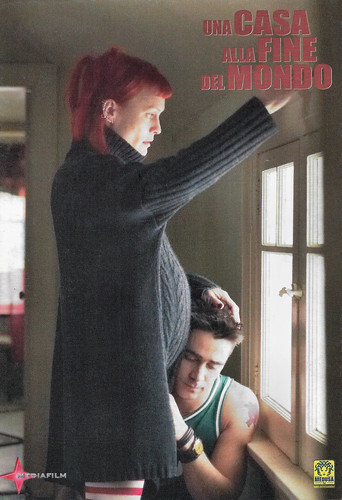
Italian postcard by Media Film, Milano. Photo: Media Film / Medusa. Robin Wright and Colin Farrell in A Home at the End of the World (Michael Mayer, 2004).
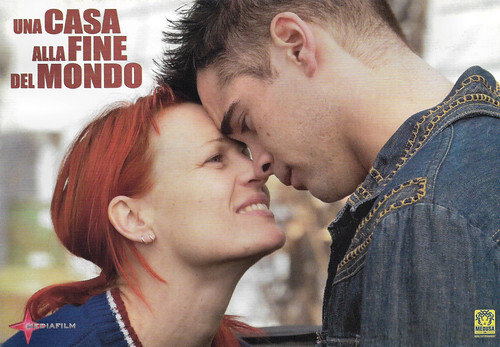
Italian postcard by Media Film, Milano. Photo: Media Film / Medusa. Robin Wright and Colin Farrell in A Home at the End of the World (Michael Mayer, 2004).
Farrell's Bobby is suddenly an asexual puppy dog
Roger Ebert of the Chicago Sun-Times wrote: "The movie exists outside our expectations for such stories. Nothing about it is conventional. The three-member household is puzzling not only to us but to its members. We expect conflict, resolution, an ending happy or sad, but what we get is mostly life, muddling through ... Colin Farrell is astonishing in the movie, not least because the character is such a departure from everything he has done before."
At AllMovie, Derek Armstrong is much more negative: "The title A Home at the End of the World gives off both an optimistic and a pessimistic vibe, simultaneously, which is appropriate for a film that can't figure out what its tone should be. For example, the plot follows the protagonist (Colin Farrell's Bobby) through the deaths of a half-dozen important family members and friends, yet Duncan Sheik's dopey score is better suited to an annoyingly whimsical romantic comedy.
That dopiness is, however, well suited to Farrell's performance. Despite the succession of traumas his character endures, his attitude rarely changes from that of a pseudo-hippie naïf. It's hard to tell whether that's a reflection on director Michael Mayer's vision for the character, or Farrell's limitations as an actor, but it rings terribly false."
Finally, Wes Connors at IMDb : "indeed, it is a portrait of an unconventional family unit, but that should have remained secondary. At heart, this is a love (the kind including a sexual attraction) story between the Bobby and Jonathan characters, possibly deemphasized to make it more palatable. The focus unravels, especially after Mr. Farrell's adult Bobby takes over the action.
The film draws its fault line by losing touch with the central relationship, and Farrell's characterization goes off course. Freed-from-the-wig Colin Farrell and Dallas Roberts could have recorded a hit version of "Look Out, Cleveland" with The Band backing... The casting is excellent, with Erik Smith and Harris Allan especially winning as the teenage Bobby and Jonathan; they blend perfectly with the grown-up Farrell and Mr. Roberts.
Note that criticisms of Farrell in the lead role are of characterization, not acting. Smith's Bobby was played as a self-assured and sexually adventurous young man, but Farrell's Bobby is suddenly an asexual puppy dog; something is missing."
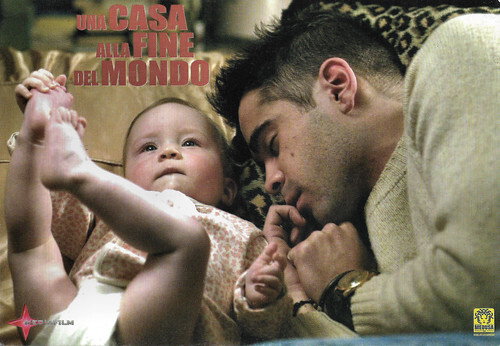
Italian postcard by Media Film, Milano. Photo: Media Film / Medusa. Colin Farrell in A Home at the End of the World (Michael Mayer, 2004).
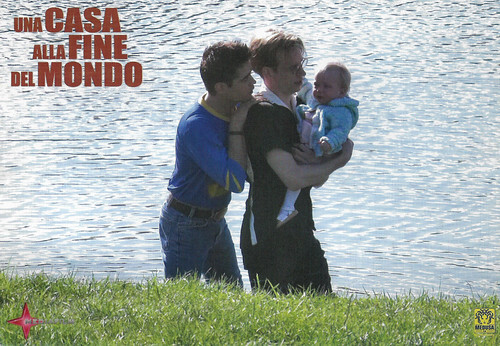
Italian postcard by Media Film, Milano. Photo: Media Film / Medusa. Colin Farrell and Dallas Roberts in A Home at the End of the World (Michael Mayer, 2004).
Sources: Roger Ebert (Roger Ebert.com), Derek Armstrong (AllMovie), Wes Connors (IMDb), Wikipedia, and IMDb.

Italian postcard by Media Film, Milano. Photo: Media Film / Medusa. Colin Farrell in A Home at the End of the World (Michael Mayer, 2004).

Italian postcard by Media Film, Milano. Photo: Media Film / Medusa. Dallas Roberts and Colin Farrell in A Home at the End of the World (Michael Mayer, 2004).
A journey of trials, triumphs, loves, and losses
A Home at the End of the World (Michael Mayer, 2004) is based on a novel by Michael Cunningham, the Pulitzer Prize-winning author of 'The Hours'. The film chronicles a dozen years in the lives of two best friends who couldn't be more different.
We follow them from suburban Cleveland in the 1960s to New York City in the 1980s. Bobby Morrow's (Colin Farrell) life has been tinged with tragedy since he was a young boy, losing first his beloved older brother to a freak accident, then his mother to illness, and finally his father.
As a rebellious teenager, he meets the conservative and gawky Jonathan Glover (Dallas Roberts) in high school, and he becomes a regular visitor to the Glover home, where he introduces his friend and his mother Alice (Sissy Spacek) to marijuana and the music of Laura Nyro. Jonathan, who is slowly coming out as a homosexual, initiates Bobby into adolescent mutual masturbation during their frequent sleepovers.
When Alice catches them both masturbating in a car, Jonathan, embarrassed, tells Bobby he is going to leave as soon as he finishes high school. Alice teaches Bobby how to bake, unintentionally setting him on a career path that eventually takes him to New York City, where Jonathan is sharing a colorful East Village apartment with bohemian Clare (Robin Wright).
Bobby moves in, and the three create their own household. A Home at the End of the World charts a journey of trials, triumphs, loves, and losses. The question is: can they navigate the unusual triangle they've created and hold their friendship together?

Italian postcard by Media Film, Milano. Photo: Media Film / Medusa. Robin Wright and Colin Farrell in A Home at the End of the World (Michael Mayer, 2004).

Italian postcard by Media Film, Milano. Photo: Media Film / Medusa. Robin Wright and Colin Farrell in A Home at the End of the World (Michael Mayer, 2004).
Farrell's Bobby is suddenly an asexual puppy dog
Roger Ebert of the Chicago Sun-Times wrote: "The movie exists outside our expectations for such stories. Nothing about it is conventional. The three-member household is puzzling not only to us but to its members. We expect conflict, resolution, an ending happy or sad, but what we get is mostly life, muddling through ... Colin Farrell is astonishing in the movie, not least because the character is such a departure from everything he has done before."
At AllMovie, Derek Armstrong is much more negative: "The title A Home at the End of the World gives off both an optimistic and a pessimistic vibe, simultaneously, which is appropriate for a film that can't figure out what its tone should be. For example, the plot follows the protagonist (Colin Farrell's Bobby) through the deaths of a half-dozen important family members and friends, yet Duncan Sheik's dopey score is better suited to an annoyingly whimsical romantic comedy.
That dopiness is, however, well suited to Farrell's performance. Despite the succession of traumas his character endures, his attitude rarely changes from that of a pseudo-hippie naïf. It's hard to tell whether that's a reflection on director Michael Mayer's vision for the character, or Farrell's limitations as an actor, but it rings terribly false."
Finally, Wes Connors at IMDb : "indeed, it is a portrait of an unconventional family unit, but that should have remained secondary. At heart, this is a love (the kind including a sexual attraction) story between the Bobby and Jonathan characters, possibly deemphasized to make it more palatable. The focus unravels, especially after Mr. Farrell's adult Bobby takes over the action.
The film draws its fault line by losing touch with the central relationship, and Farrell's characterization goes off course. Freed-from-the-wig Colin Farrell and Dallas Roberts could have recorded a hit version of "Look Out, Cleveland" with The Band backing... The casting is excellent, with Erik Smith and Harris Allan especially winning as the teenage Bobby and Jonathan; they blend perfectly with the grown-up Farrell and Mr. Roberts.
Note that criticisms of Farrell in the lead role are of characterization, not acting. Smith's Bobby was played as a self-assured and sexually adventurous young man, but Farrell's Bobby is suddenly an asexual puppy dog; something is missing."

Italian postcard by Media Film, Milano. Photo: Media Film / Medusa. Colin Farrell in A Home at the End of the World (Michael Mayer, 2004).

Italian postcard by Media Film, Milano. Photo: Media Film / Medusa. Colin Farrell and Dallas Roberts in A Home at the End of the World (Michael Mayer, 2004).
Sources: Roger Ebert (Roger Ebert.com), Derek Armstrong (AllMovie), Wes Connors (IMDb), Wikipedia, and IMDb.
Published on May 17, 2022 22:00
May 16, 2022
Cannes Film Festival
Every year, in the third week of May, international filmmakers, stars, film industry professionals and thousands of journalists go to the Côte d'Azur. They visit the most prestigious film festival in the world, the Cannes Film Festival (Festival de Cannes). The festival starts today.
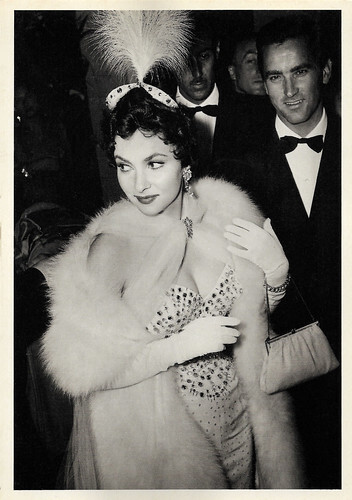
French postcard by Editions Admira in the Collection 'Portraits de cinema" (1st series), no. 12, 1987. Photo: Léo Mirkine. Caption: Gina Lollobrigida , Cannes (1959).
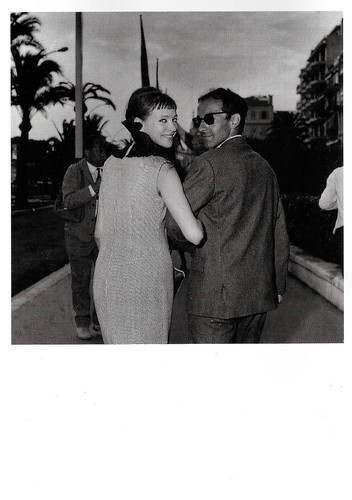
French postcard by Editions Cahiers du Cinéma, Paris, 1997. Photo: Traverso. Caption: Anna Karina and Jean-Luc Godard , Festival de Cannes 1963.
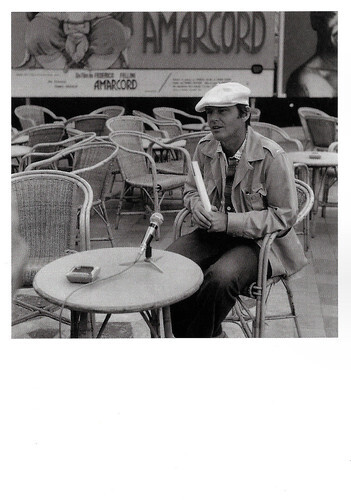
French postcard by Editions Cahiers de cinéma, Paris, 1997. Caption: Jack Nicholson , Festival de Cannes 1974.
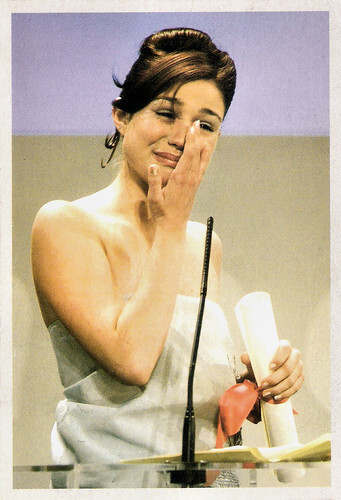
Belgian postcard by Ed. resp. P. Hurbain, Bruxelles, no. 148. Photo: Laurent Rebours / AP. Caption: Cannes 1999: Rosetta, the film by the Dardenne brothers, receives the Grand Prix, and Émilie Dequenne wins the award for Best Actress.
The Golden Palm
The Cannes Film Festival has been held every year in the French city of Cannes since 1946. The venue is the Palais des Festivals et des Congrès on the La Croisette promenade.
The most important prize awarded at Cannes is the Palme d'Or (Golden Palm) for the best film in the International Competition. The Golden Palm is sometimes shared by several films in the same year.
Other prizes awarded by the jury for the film as a whole are (in descending order) the Grand Prize of the Jury (Grand Prix du Jury), the Prize of the Jury (Prix du Jury) and the Special Prize of the Jury (not necessarily awarded every year). There are also prizes in the individual categories of female actor, male actor, director and screenplay.
The awards in Cannes are given by a jury made up of several people, usually experienced and award-winning professionals from the film industry. Other juries also award competition films here. The most important are the FIPRESCI Prize of International Film Critics (Prix de la FIPRESCI) and the Ecumenical Jury Prize (Prix du Jury oecuménique).
In addition to the main competition, there is also the short film competition with the Palme d'Or for short films (Palme d'Or du court métrage), the Cinéfondation competition, in which works by film students are awarded, as well as the Un Certain Regard series, in which the Prix Un Certain Regard has been awarded since 1998.
Within the framework of the international film festival, both the directors' association Société des Réalisateurs de Films with its La Quinzaine des Réalisateurs and the critics' organisation Syndicat français de la critique de cinéma with its La Semaine Internationale de la Critique hold their own independent parallel event at which a number of prizes are also awarded.
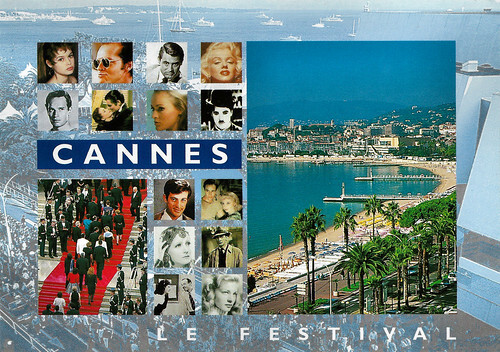
French postcard by Images - Distribution. Image: Photos D.R.
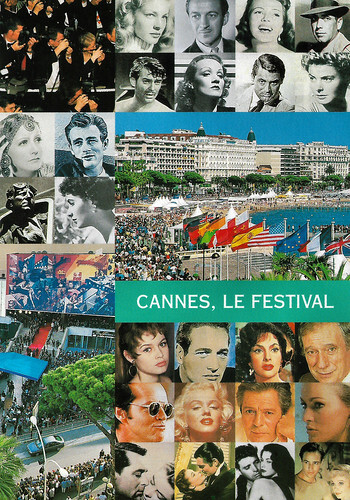
French postcard by Images - Distribution. Image: Photos D.R. Caption: Cannes (Alpes-Maritimes) Le Festival.
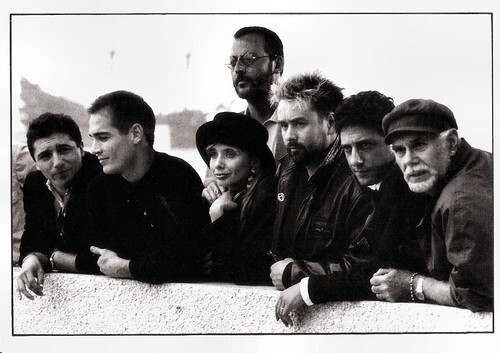
French postcard by News Productions, Beaulmes, no 56063. Photo: Eric Coiffier. Director and cast of Le Grand Bleu (Luc Besson, 1988) at the Festival de Cannes, 1988. With in the front row from left to right: Marc Duret, Jean-Marc Barr , Rosanna Arquette, Luc Besson, Sergio Castellitto and Andréas Voutsinas.
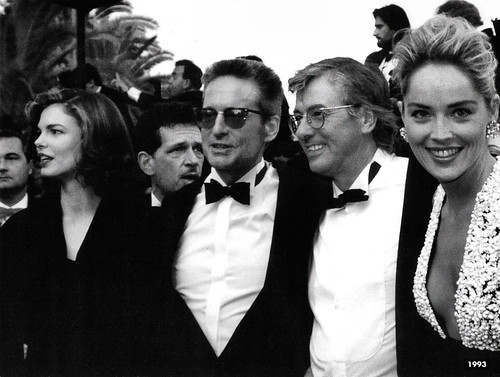
Big photo, 1993. Jeanne Tripplehorn, Michael Douglas , Paul Verhoeven , Sharon Stone at the Premiere of Basic Instinct (Paul Verhoeven, 1992) in Cannes.
24 Stairs to glory
The Cannes Film Festival receives a lot of media attention, it is attended by many film stars and is a popular opportunity for film producers to present their new films and sell them to distributors. The film stars are transported in luxurious limousines to the famous red carpet, where they climb the "24 stairs to glory" and to be hidden from public view.
From the 1950s onwards, Cannes became the biggest event in world cinema. Gradually, as the critic André Bazin wished, the festival became more concerned with cinema and less with mundanities, patriotism and diplomacy. Until the 1970s, embassies presented the films chosen by their governments.
Major filmmakers presented major works at the festival: Roberto Rossellini, Federico Fellini, Ingmar Bergman , Elia Kazan, Joseph L. Mankiewicz, Robert Wise, William Wyler, Michelangelo Antonioni, Vittorio De Sica , Andrzej Wajda, Satyajit Ray, Luis Buñuel, Akira Kurosawa, Martin Scorsese, Paul Verhoeven and Quentin Tarantino .
In 1997, on the occasion of the 50th Cannes Film Festival, Ingmar Bergman was awarded the "Palm of Palms" in the presence of many previous winners. In 2012 the president of the Festival at the time, Gilles Jacob, expressed regret about the monumentality of the event, which had lost its humanity compared to the time when Kirk Douglas played football with journalists and the stars walked to the beach:
"The Festival should stop growing, so as not to become an embarrassment. Cannes is the most beautiful city for a film festival, but it must remain a pleasure, not a constraint. [...] There are more and more people and media who want to come, we can't forbid them. [...] When the stars come down to the bottom of the steps, some talk to people, others don't. Many give nothing but the usual, devote themselves to their work. Many just give the agreed-upon, spend a short day with the press, and leave. It's almost like a factory."
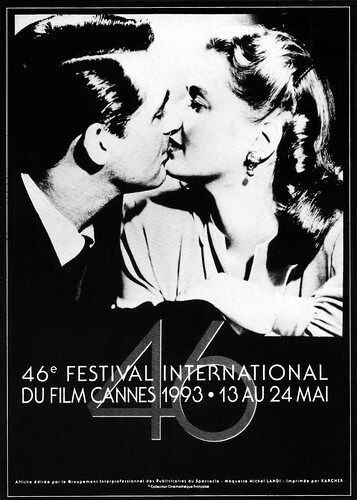
French postcard by Mondial Projection S.A., Paris. Image: poster for 46e Festival International Du Film Cannes 1993. Design: Michel Landi. Photo: Collection Cinémathèque Française. Ingrid Bergman and Cary Grant in Notorious (Alfred Hitchcock, 1946).
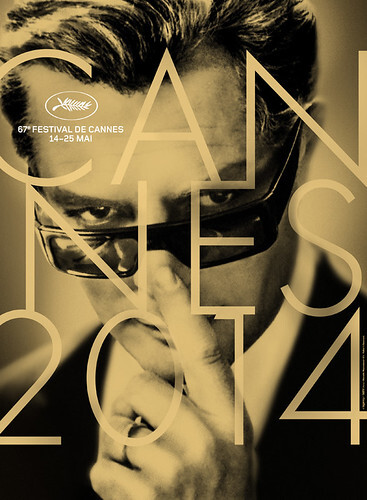
French postcard. Caption: Cannes 2014. 67e Festival de Cannes 14-25 Mai. Photo: Marcello Mastroianni in La dolce vita (Federico Fellini, 1960).
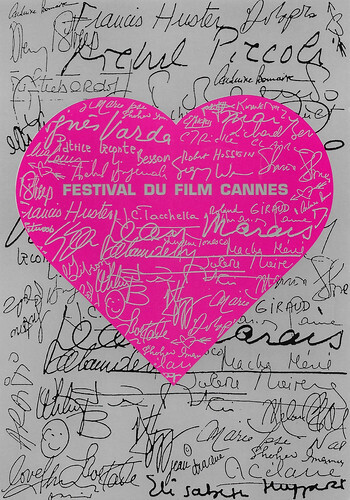
French postcard by Davis. Design: Sylvie Cruguet. Caption: Festival du Film - Cannes 2004.
Cancelled in 1968
The Cannes Film Festival was conceived on the initiative of the French Minister of Education and Culture, Jean Zay. Originally planned for 1939, the first Cannes International Film Festival took place for the first time from 20 September to 5 October 1946 due to the Second World War.
In 1948 and 1950, the festival was cancelled due to financing difficulties. In 1955, the best film was awarded the Palme d'Or for the first time. The trophy, designed by French jeweller Lucienne Lazon, replaced the "Grand Prix" which had been awarded until then.
As a result of the Paris May riots, the 1968 festival was cancelled on 19 May. Louis Malle had already resigned as a member of the jury the evening before. Malle, François Truffaut , Claude Berri, Jean-Gabriel Albicocco, Claude Lelouch, Roman Polański and Jean-Luc Godard invaded the Great Hall of the Palais des Festivals and demanded the interruption of the screening as a show of solidarity with the striking workers and students.
The action was also seen as a response to the dismissal of Henri Langlois as director of the Cinémathèque française shortly before. In 2014, Gilles Jacob became honorary president after 38 years of directing the Festival, his successor is Pierre Lescure.
The Film Market facilitates exchanges between buyers and sellers in the film industry and has become the world's leading platform for the international film trade. In 2007, it hosted over 10,000 participants from 91 countries.
In 2017, the festival celebrated its 70th edition, inviting award-winning filmmakers and screenings of series by great filmmakers. Today, the official selection is intended to reflect the world's film production. The competition generally highlights auteur or research films. The question of creating an award for original music has been raised.
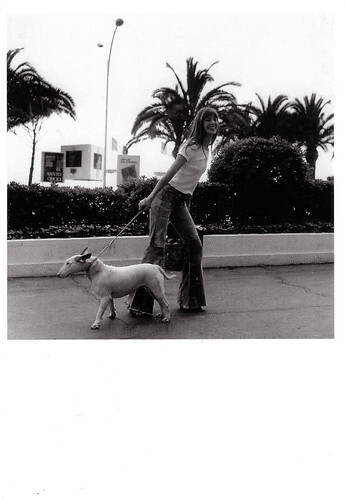
French postcard by Editions Cahiers de cinéma, Paris, 1997. Photo: Traverso. Caption: Jane Birkin , Festival de Cannes 1974.
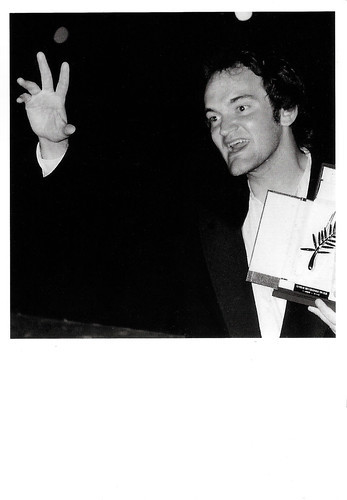
French postcard by Editions Cahiers du Cinéma, Paris, 1997. Photo: Traverso. Quentin Tarantino , Festival de Cannes 1994.
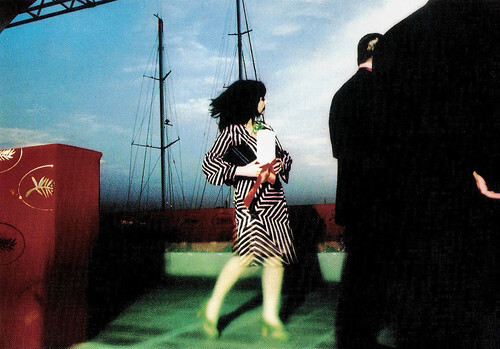
French postcard by Cartcom. Photo: Sandrine Expily / Studio Magazine. Caption: Björk, Prix d'interprétation pour Dancer in the Dark. Cannes 2000. The photo was part of theexhibition 'Un Regard sur Cannes', presented at the UGC Ciné Cité Strasbourg-Étoile.
Sources: Wikipedia (French, Dutch and German) and Festival de Cannes.

French postcard by Editions Admira in the Collection 'Portraits de cinema" (1st series), no. 12, 1987. Photo: Léo Mirkine. Caption: Gina Lollobrigida , Cannes (1959).

French postcard by Editions Cahiers du Cinéma, Paris, 1997. Photo: Traverso. Caption: Anna Karina and Jean-Luc Godard , Festival de Cannes 1963.

French postcard by Editions Cahiers de cinéma, Paris, 1997. Caption: Jack Nicholson , Festival de Cannes 1974.

Belgian postcard by Ed. resp. P. Hurbain, Bruxelles, no. 148. Photo: Laurent Rebours / AP. Caption: Cannes 1999: Rosetta, the film by the Dardenne brothers, receives the Grand Prix, and Émilie Dequenne wins the award for Best Actress.
The Golden Palm
The Cannes Film Festival has been held every year in the French city of Cannes since 1946. The venue is the Palais des Festivals et des Congrès on the La Croisette promenade.
The most important prize awarded at Cannes is the Palme d'Or (Golden Palm) for the best film in the International Competition. The Golden Palm is sometimes shared by several films in the same year.
Other prizes awarded by the jury for the film as a whole are (in descending order) the Grand Prize of the Jury (Grand Prix du Jury), the Prize of the Jury (Prix du Jury) and the Special Prize of the Jury (not necessarily awarded every year). There are also prizes in the individual categories of female actor, male actor, director and screenplay.
The awards in Cannes are given by a jury made up of several people, usually experienced and award-winning professionals from the film industry. Other juries also award competition films here. The most important are the FIPRESCI Prize of International Film Critics (Prix de la FIPRESCI) and the Ecumenical Jury Prize (Prix du Jury oecuménique).
In addition to the main competition, there is also the short film competition with the Palme d'Or for short films (Palme d'Or du court métrage), the Cinéfondation competition, in which works by film students are awarded, as well as the Un Certain Regard series, in which the Prix Un Certain Regard has been awarded since 1998.
Within the framework of the international film festival, both the directors' association Société des Réalisateurs de Films with its La Quinzaine des Réalisateurs and the critics' organisation Syndicat français de la critique de cinéma with its La Semaine Internationale de la Critique hold their own independent parallel event at which a number of prizes are also awarded.

French postcard by Images - Distribution. Image: Photos D.R.

French postcard by Images - Distribution. Image: Photos D.R. Caption: Cannes (Alpes-Maritimes) Le Festival.

French postcard by News Productions, Beaulmes, no 56063. Photo: Eric Coiffier. Director and cast of Le Grand Bleu (Luc Besson, 1988) at the Festival de Cannes, 1988. With in the front row from left to right: Marc Duret, Jean-Marc Barr , Rosanna Arquette, Luc Besson, Sergio Castellitto and Andréas Voutsinas.

Big photo, 1993. Jeanne Tripplehorn, Michael Douglas , Paul Verhoeven , Sharon Stone at the Premiere of Basic Instinct (Paul Verhoeven, 1992) in Cannes.
24 Stairs to glory
The Cannes Film Festival receives a lot of media attention, it is attended by many film stars and is a popular opportunity for film producers to present their new films and sell them to distributors. The film stars are transported in luxurious limousines to the famous red carpet, where they climb the "24 stairs to glory" and to be hidden from public view.
From the 1950s onwards, Cannes became the biggest event in world cinema. Gradually, as the critic André Bazin wished, the festival became more concerned with cinema and less with mundanities, patriotism and diplomacy. Until the 1970s, embassies presented the films chosen by their governments.
Major filmmakers presented major works at the festival: Roberto Rossellini, Federico Fellini, Ingmar Bergman , Elia Kazan, Joseph L. Mankiewicz, Robert Wise, William Wyler, Michelangelo Antonioni, Vittorio De Sica , Andrzej Wajda, Satyajit Ray, Luis Buñuel, Akira Kurosawa, Martin Scorsese, Paul Verhoeven and Quentin Tarantino .
In 1997, on the occasion of the 50th Cannes Film Festival, Ingmar Bergman was awarded the "Palm of Palms" in the presence of many previous winners. In 2012 the president of the Festival at the time, Gilles Jacob, expressed regret about the monumentality of the event, which had lost its humanity compared to the time when Kirk Douglas played football with journalists and the stars walked to the beach:
"The Festival should stop growing, so as not to become an embarrassment. Cannes is the most beautiful city for a film festival, but it must remain a pleasure, not a constraint. [...] There are more and more people and media who want to come, we can't forbid them. [...] When the stars come down to the bottom of the steps, some talk to people, others don't. Many give nothing but the usual, devote themselves to their work. Many just give the agreed-upon, spend a short day with the press, and leave. It's almost like a factory."

French postcard by Mondial Projection S.A., Paris. Image: poster for 46e Festival International Du Film Cannes 1993. Design: Michel Landi. Photo: Collection Cinémathèque Française. Ingrid Bergman and Cary Grant in Notorious (Alfred Hitchcock, 1946).

French postcard. Caption: Cannes 2014. 67e Festival de Cannes 14-25 Mai. Photo: Marcello Mastroianni in La dolce vita (Federico Fellini, 1960).

French postcard by Davis. Design: Sylvie Cruguet. Caption: Festival du Film - Cannes 2004.
Cancelled in 1968
The Cannes Film Festival was conceived on the initiative of the French Minister of Education and Culture, Jean Zay. Originally planned for 1939, the first Cannes International Film Festival took place for the first time from 20 September to 5 October 1946 due to the Second World War.
In 1948 and 1950, the festival was cancelled due to financing difficulties. In 1955, the best film was awarded the Palme d'Or for the first time. The trophy, designed by French jeweller Lucienne Lazon, replaced the "Grand Prix" which had been awarded until then.
As a result of the Paris May riots, the 1968 festival was cancelled on 19 May. Louis Malle had already resigned as a member of the jury the evening before. Malle, François Truffaut , Claude Berri, Jean-Gabriel Albicocco, Claude Lelouch, Roman Polański and Jean-Luc Godard invaded the Great Hall of the Palais des Festivals and demanded the interruption of the screening as a show of solidarity with the striking workers and students.
The action was also seen as a response to the dismissal of Henri Langlois as director of the Cinémathèque française shortly before. In 2014, Gilles Jacob became honorary president after 38 years of directing the Festival, his successor is Pierre Lescure.
The Film Market facilitates exchanges between buyers and sellers in the film industry and has become the world's leading platform for the international film trade. In 2007, it hosted over 10,000 participants from 91 countries.
In 2017, the festival celebrated its 70th edition, inviting award-winning filmmakers and screenings of series by great filmmakers. Today, the official selection is intended to reflect the world's film production. The competition generally highlights auteur or research films. The question of creating an award for original music has been raised.

French postcard by Editions Cahiers de cinéma, Paris, 1997. Photo: Traverso. Caption: Jane Birkin , Festival de Cannes 1974.

French postcard by Editions Cahiers du Cinéma, Paris, 1997. Photo: Traverso. Quentin Tarantino , Festival de Cannes 1994.

French postcard by Cartcom. Photo: Sandrine Expily / Studio Magazine. Caption: Björk, Prix d'interprétation pour Dancer in the Dark. Cannes 2000. The photo was part of theexhibition 'Un Regard sur Cannes', presented at the UGC Ciné Cité Strasbourg-Étoile.
Sources: Wikipedia (French, Dutch and German) and Festival de Cannes.
Published on May 16, 2022 22:00
May 15, 2022
Hannelore Schroth
German actress Hannelore Schroth (1922-1987) made her film debut at the age of nine and a long and successful career in both theatre and cinema followed. She starred in Helmut Käutner's Unter den Brücken/Under the bridges (1945), one of the most beautiful love stories of the German cinema – without any trace of propaganda.
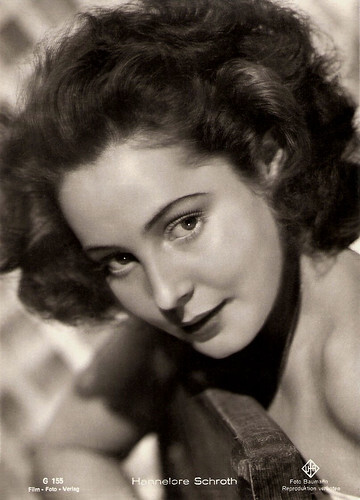
German postcard by Film-Foto-Verlag, no. G 155, 1941-1944. Photo: Baumann / Ufa.
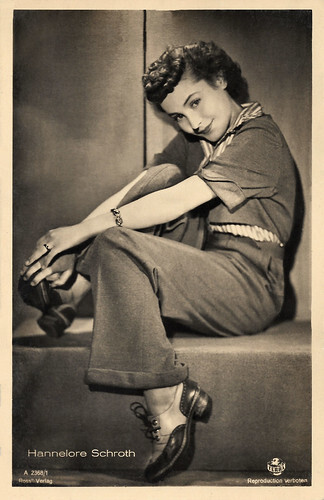
German postcard by Ross Verlag, no. A 2368/1, 1939-1940. Photo: Terra.
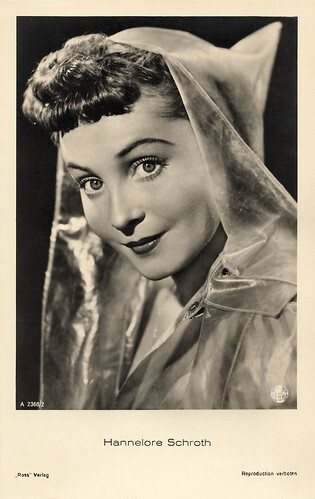
German postcard by Ross Verlag, no. A 2368/2, 1939-1940. Photo: Terra.
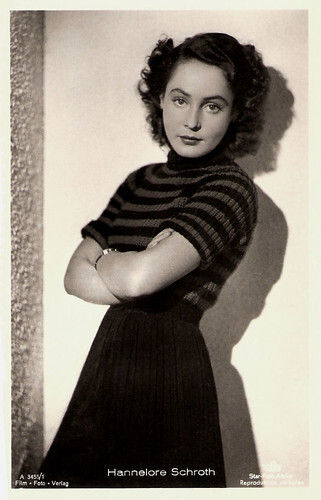
German postcard by Film-Foto-Verlag, no. A 3455/1, 1941-1944. Photo: Star-Foto-Atelier / Tobis.
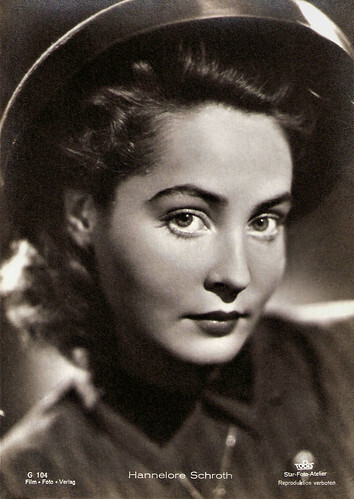
German postcard by Film-Foto-Verlag, no. G 104, 1941-1944. Photo: Star-Foto-Atelier / Tobis.
Wonderfully natural
Hanne Lore Emilie Käte Grete Schroth was born in Berlin in 1922 as the daughter of actor Heinrich Schroth and actress Käthe Haack . Her half-brother Carl-Heinz Schroth would also become a well-known actor.
Hannelore already made her film debut at the age of nine in the short comedy Dann schon lieber Lebertran/I'd Rather Have Cod Liver Oil (Max Ophüls, 1931) opposite her mother, Käthe Haack . At sixteen, she attended a drama school in Lausanne.
To her early successes belong the love story Spiel im Sommerwind/Play in the Summer Breezes (Roger von Norman, 1938) with Rolf Möbius, and Kitty und die Weltkonferenz/Kitty and the World Conference (Helmut Käutner, 1939).
During the wartime, she continued her career with leading parts in Friedrich Schiller (Herbert Maisch, 1940) about the 18th-century German playwright and blank-verse poet, the romantic comedy Sophienlund (Heinz Rühmann, 1944) and Unter den Brücken/Under the Bridge (Helmut Käutner, 1945), a classic love triangle with Carl Raddatz and Gustav Knuth.
IMDb reviewer Christian Wasser calls the latter "one of the most beautiful love stories of the German cinema. The acting of Hannelore Schroth is wonderfully natural even today".
Unter den Brücken was one of the last films to be made in Nazi Germany - it passed the censorship in March 1945, but didn't make it to the cinemas as the street battles were about to commence in Berlin in a few weeks. In 1950, the film was finally shown in cinemas.
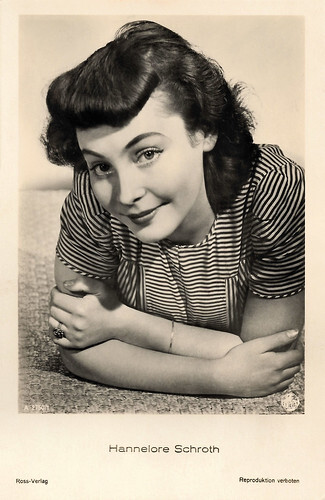
German postcard by Ross Verlag, no. A 2750/1, 1939-1940. Photo: Terra.
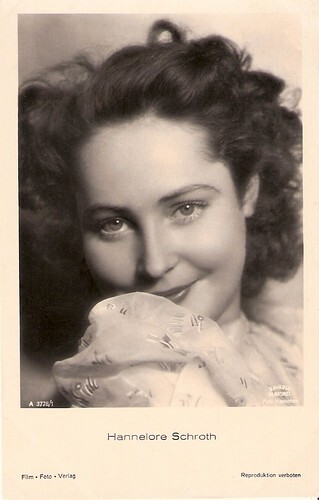
German postcard by Film-Foto-Verlag, no. A 3776/1, 1941-1944. Photo: Foto Haenchen / Bavaria Filmkunst.
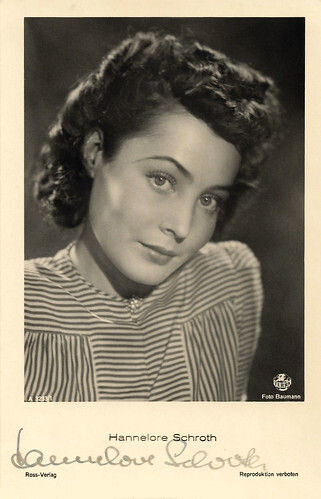
German postcard by Ross Verlag, no. A 3233/1, 1941-1944. Photo: Baumann / Terra.
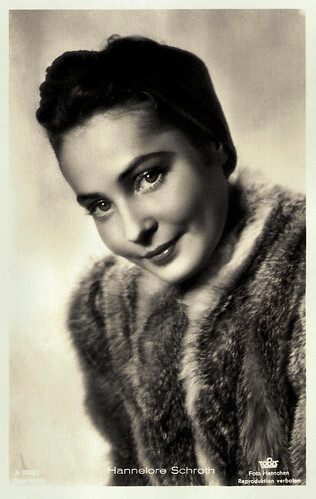
German postcard by Ross Verlag, no. A 3233/2, 1941-1944. Photo: Haenchen / Tobis.
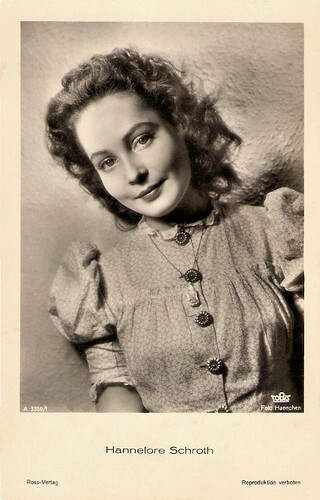
German postcard by Ross Verlag, no. A 3359/1, 1941-1944. Photo: Haenchen / Tobis.
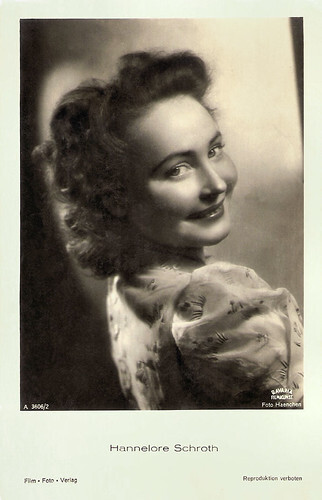
German postcard by Film-Foto-Verlag, no. A 3606/2, 1941-1944. Photo: Haenchen / Bavaria Filmkunst.
Emiiiil
After the war, Hannelore Schroth gained a foothold at the theater and also continued her film career with such hits as Taxi-Kitty (Kurt Hoffmann, 1950) and Kommen Sie am Ersten/Come at the First (Erich Engel, 1951).
Later well-known films are the classic comedy Der Hauptmann von Köpenick/The Captain from Köpenick (Helmut Käutner, 1956), the romantic drama Wie einst Lili Marleen/Like Once Lili Marleen (Paul Verhoeven, 1956) with the wartime song hit Lili Marlene woven into its plotline, and the comedy Der Mann, der nicht nein sagen konnte/The Man Who Could Not say No (Kurt Früh, 1958) with Heinz Rühmann .
She also became a popular voice actor and dubbed such Hollywood stars as Shirley MacLaine and Elizabeth Taylor .
From the 1950s on, regular engagements for TV followed. She became well-known for a younger audience when she impersonated the role of Mrs. Petrell in the successful Swedish film- and TV series Emil (Olle Hellbom, 1971-1976). The three feature films and the TV series were based on the novels by Astrid Lindgren about the 5-year-old prankster Emil, who lives with his family on a farm in the district of Lönneberga in Sweden, at the start of the 20th century.
To Hannelore Schroth's last films belong the comedy Bomber & Paganini (Nicos Perakis, 1976) starring Mario Adorf , and Zwischengleis/Yesterday's Tomorrow (Wolfgang Staudte, 1978) with Pola Kinski. In 1980, Schroth was awarded the Filmband in Gold for her achievements in German cinema.
Hannelore Schroth died in 1987 in München (Munich). She had been married to the actor Carl Raddatz , her co-star of Unter den Brücken, and from 1945 till 1950 with the Austrian deep-sea diver Hans Hass. Her son from that marriage, Hans Hass Jr., was an actor and singer. From her third marriage with a lawyer and film producer also comes a son, Christopher Köster.
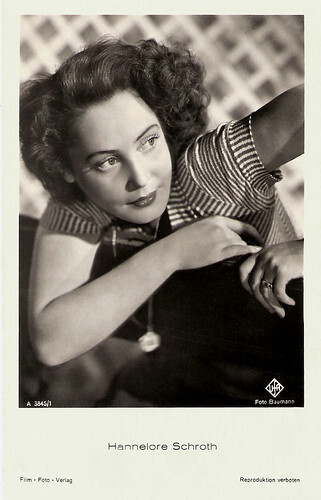
German postcard by Film-Foto-Verlag, no. A 3845/1, 1941-1944. Photo: Baumann / Ufa.
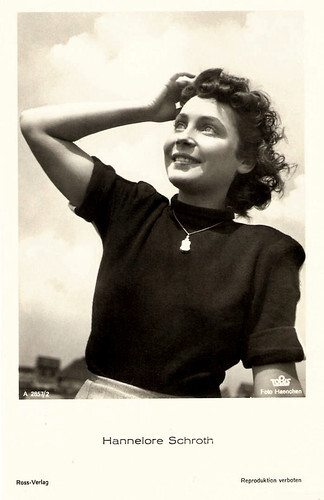
German postcard by Ross Verlag, no. A 2857/1, 1939-1940. Photo: Haenchen / Tobis.
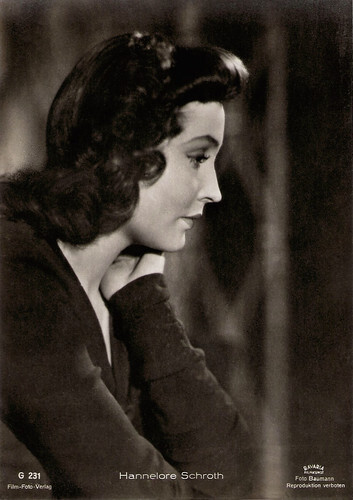
German postcard by Film-Foto-Verlag, no. G 231, 1941-1944. Photo: Baumann / Bavaria.
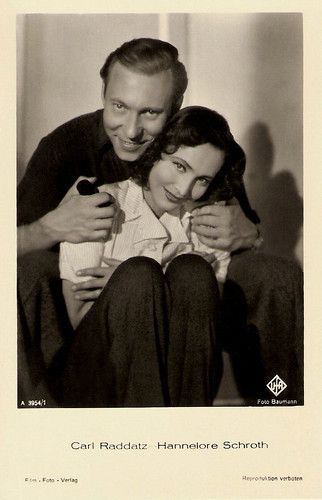
With Carl Raddatz . German postcard by Film-Foto-Verlag, no. A 3954/1, 1941-1944. Photo: Baumann / Ufa.
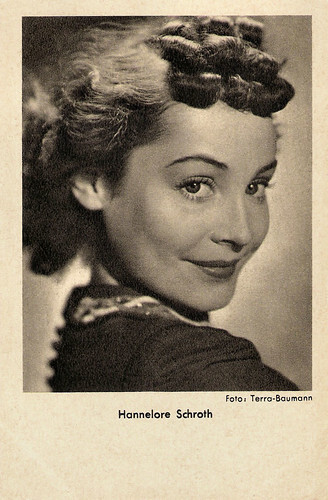
German postcard. Photo: Baumann / Terra.
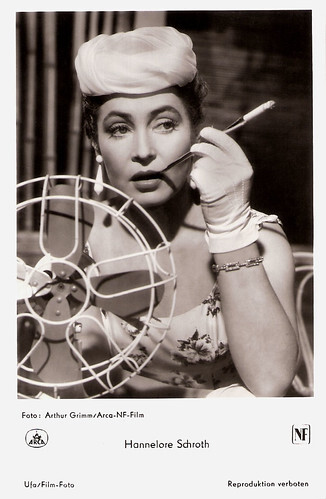
German postcard by Ufa, Berlin-Tempelhof, no. FK 3492. Retail price: 25 Pfg. Photo: Arthur Grimm / Arca-NF-Film.
Sources: Thomas Staedeli (Cyranos), Filmportal.de, Wikipedia (German), and .

German postcard by Film-Foto-Verlag, no. G 155, 1941-1944. Photo: Baumann / Ufa.

German postcard by Ross Verlag, no. A 2368/1, 1939-1940. Photo: Terra.

German postcard by Ross Verlag, no. A 2368/2, 1939-1940. Photo: Terra.

German postcard by Film-Foto-Verlag, no. A 3455/1, 1941-1944. Photo: Star-Foto-Atelier / Tobis.

German postcard by Film-Foto-Verlag, no. G 104, 1941-1944. Photo: Star-Foto-Atelier / Tobis.
Wonderfully natural
Hanne Lore Emilie Käte Grete Schroth was born in Berlin in 1922 as the daughter of actor Heinrich Schroth and actress Käthe Haack . Her half-brother Carl-Heinz Schroth would also become a well-known actor.
Hannelore already made her film debut at the age of nine in the short comedy Dann schon lieber Lebertran/I'd Rather Have Cod Liver Oil (Max Ophüls, 1931) opposite her mother, Käthe Haack . At sixteen, she attended a drama school in Lausanne.
To her early successes belong the love story Spiel im Sommerwind/Play in the Summer Breezes (Roger von Norman, 1938) with Rolf Möbius, and Kitty und die Weltkonferenz/Kitty and the World Conference (Helmut Käutner, 1939).
During the wartime, she continued her career with leading parts in Friedrich Schiller (Herbert Maisch, 1940) about the 18th-century German playwright and blank-verse poet, the romantic comedy Sophienlund (Heinz Rühmann, 1944) and Unter den Brücken/Under the Bridge (Helmut Käutner, 1945), a classic love triangle with Carl Raddatz and Gustav Knuth.
IMDb reviewer Christian Wasser calls the latter "one of the most beautiful love stories of the German cinema. The acting of Hannelore Schroth is wonderfully natural even today".
Unter den Brücken was one of the last films to be made in Nazi Germany - it passed the censorship in March 1945, but didn't make it to the cinemas as the street battles were about to commence in Berlin in a few weeks. In 1950, the film was finally shown in cinemas.

German postcard by Ross Verlag, no. A 2750/1, 1939-1940. Photo: Terra.

German postcard by Film-Foto-Verlag, no. A 3776/1, 1941-1944. Photo: Foto Haenchen / Bavaria Filmkunst.

German postcard by Ross Verlag, no. A 3233/1, 1941-1944. Photo: Baumann / Terra.

German postcard by Ross Verlag, no. A 3233/2, 1941-1944. Photo: Haenchen / Tobis.

German postcard by Ross Verlag, no. A 3359/1, 1941-1944. Photo: Haenchen / Tobis.

German postcard by Film-Foto-Verlag, no. A 3606/2, 1941-1944. Photo: Haenchen / Bavaria Filmkunst.
Emiiiil
After the war, Hannelore Schroth gained a foothold at the theater and also continued her film career with such hits as Taxi-Kitty (Kurt Hoffmann, 1950) and Kommen Sie am Ersten/Come at the First (Erich Engel, 1951).
Later well-known films are the classic comedy Der Hauptmann von Köpenick/The Captain from Köpenick (Helmut Käutner, 1956), the romantic drama Wie einst Lili Marleen/Like Once Lili Marleen (Paul Verhoeven, 1956) with the wartime song hit Lili Marlene woven into its plotline, and the comedy Der Mann, der nicht nein sagen konnte/The Man Who Could Not say No (Kurt Früh, 1958) with Heinz Rühmann .
She also became a popular voice actor and dubbed such Hollywood stars as Shirley MacLaine and Elizabeth Taylor .
From the 1950s on, regular engagements for TV followed. She became well-known for a younger audience when she impersonated the role of Mrs. Petrell in the successful Swedish film- and TV series Emil (Olle Hellbom, 1971-1976). The three feature films and the TV series were based on the novels by Astrid Lindgren about the 5-year-old prankster Emil, who lives with his family on a farm in the district of Lönneberga in Sweden, at the start of the 20th century.
To Hannelore Schroth's last films belong the comedy Bomber & Paganini (Nicos Perakis, 1976) starring Mario Adorf , and Zwischengleis/Yesterday's Tomorrow (Wolfgang Staudte, 1978) with Pola Kinski. In 1980, Schroth was awarded the Filmband in Gold for her achievements in German cinema.
Hannelore Schroth died in 1987 in München (Munich). She had been married to the actor Carl Raddatz , her co-star of Unter den Brücken, and from 1945 till 1950 with the Austrian deep-sea diver Hans Hass. Her son from that marriage, Hans Hass Jr., was an actor and singer. From her third marriage with a lawyer and film producer also comes a son, Christopher Köster.

German postcard by Film-Foto-Verlag, no. A 3845/1, 1941-1944. Photo: Baumann / Ufa.

German postcard by Ross Verlag, no. A 2857/1, 1939-1940. Photo: Haenchen / Tobis.

German postcard by Film-Foto-Verlag, no. G 231, 1941-1944. Photo: Baumann / Bavaria.

With Carl Raddatz . German postcard by Film-Foto-Verlag, no. A 3954/1, 1941-1944. Photo: Baumann / Ufa.

German postcard. Photo: Baumann / Terra.

German postcard by Ufa, Berlin-Tempelhof, no. FK 3492. Retail price: 25 Pfg. Photo: Arthur Grimm / Arca-NF-Film.
Sources: Thomas Staedeli (Cyranos), Filmportal.de, Wikipedia (German), and .
Published on May 15, 2022 22:00
May 14, 2022
Published by Weenenk & Snel
Weenenk & Snel in the city of Baarn was one of the Dutch publishers that created many film star postcards, first mainly of Dutch actors in sepia and later of film stars in black and white. In 1900, Wilhelm Reinier Weenenk opened a shop in Dern Haag (The Hague) selling postcards and cityscapes. In 1905 he associated with Nicolaas François Snel and the publishing company of Mr. Weenenk continued as Weenenk & Snel. In 1935 the head offices moved to Baarn. In an advertisement in the trade journal De Band in 1957, a completely new collection was promoted with new art cards, holiday and bathing cards, windmills, flower bulb fields, summer landscapes, and, of course, film cards.

Dutch postcard by Uitg. N.V. v.h. Weenenk & Snel, Baarn, no. 133.
Beautiful Myléne Demongeot (1936) became in 1957 one of the blond sex symbols of the French cinema when she seduced Yves Montand in Les sorcières de Salem. The coquettish French actress would go on to co-star in the three Fantômas adventures and many other European films of the 1950s and 1960s. In the 1980s she also became a producer.

Dutch postcard by N.V. v.h. Weenenk & Snel, Baarn, no. 661. Photo: MGM. Steve Reeves in Morgan il pirata/Morgan the Pirate (André De Toth, Primo Zeglio, 1960).
Handsome, musclebound Steve Reeves (1926-2000) was an American bodybuilder and actor, who was a huge success in Hercules (1958) and other Peplum films, the Italian sword-and-sandal epics. At the peak of his career, around 1960, he was reputedly the highest-paid actor in Europe.
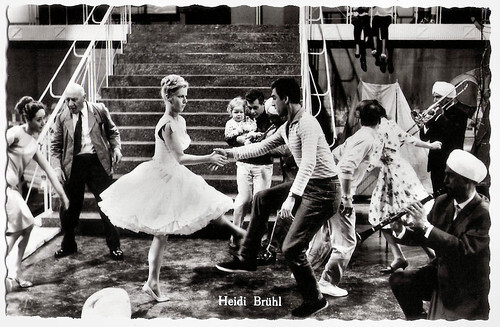
Dutch postcard by N.V. v.h. Weenenk & Snel, Baarn, no. 761. Photo: Gofilex. Heidi Brühl in Immer will ich dich gehören/Always I will be yours (Arno Assmann, 1960) with Peter Weck .
Blonde, blue-eyed schlager singer and film star Heidi Brühl (1942-1991) was called 'the Doris Day of Germany'. In 1963 she was the German participant at the Eurovision Song Contest.
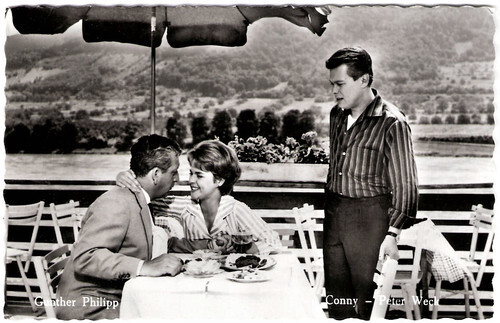
Dutch postcard by N.V. v.h. Weenenk & Snel, Baarn, no. 762. Photo: Günther Philipp, Conny Froboess and Peter Weck in Mariandl (Werner Jacobs, 1961).
Cornelia Froboess (1943) was as 'Conny' a teen idol in the late 1950s and early 1960s. Later she became a respected stage actress. Austrian actor, theatre impresario, and director Peter Weck (1930) appeared in more than 100 films. With his natural acting style in costume dramas and Heimatfilms, he became the Golden Boy from Vienna.
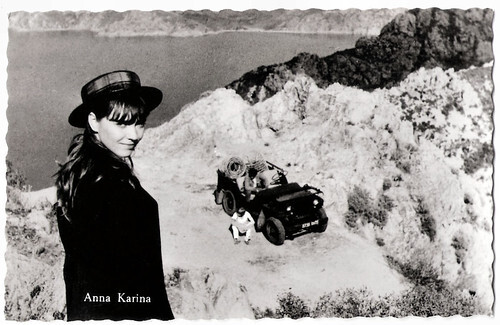
Dutch postcard by N.V. v.h. Weenenk & Snel, Baarn, no. 853. Photo: Hafbo-film. Anna Karina in Le soleil dans l'oeil/Sun in Your Eyes (Jacques Bourdon, 1962).
French, but Danish-born film actress, singer, and director Anna Karina (1940-2019) was the queen of the Nouvelle Vague. Karina was the muse of director Jean-Luc Godard and starred in eight of his films.
Dutch actors
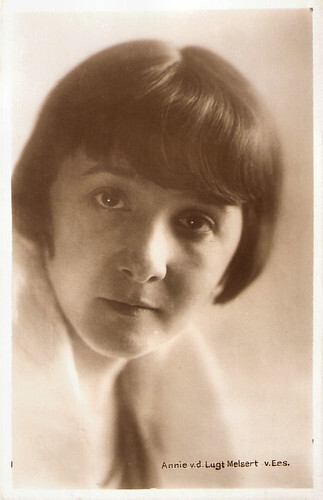
Dutch postcard by Weenenk & Snel, Den Haag. Photo: Willem Coret, Den Haag (The Hague).
Dutch actress Annie van Ees (1893-1970) performed hundreds of times in the stage play 'Boefje' (Little Rascal, 1922). Boefje is a little street boy who is always into mischief but has a heart of gold. In 1935 Annie had already played 'Boefje' 500 times, often together with her husband, stage director Cor van der Lugt Melsert. When Van Ees was 45 and mother, she starred again as Boefje in a Dutch film after the play, Boefje (1939), directed by Detlev Sierck, the future Douglas Sirk.
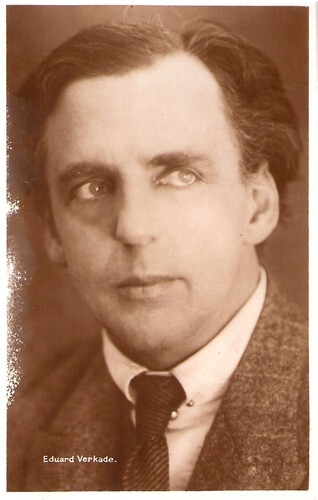
Dutch postcard by Weenenk & Snel, Den Haag. Photo: Willem Coret. Collection: Geoffrey Donaldson Institute.
Dutch actor Eduard Verkade (1878-1961) was one of the actor-directors who revolutionised Dutch theatre in the first decades of the 20th century. He also starred in Dutch films of the 1910s, 1920s, and 1930s.
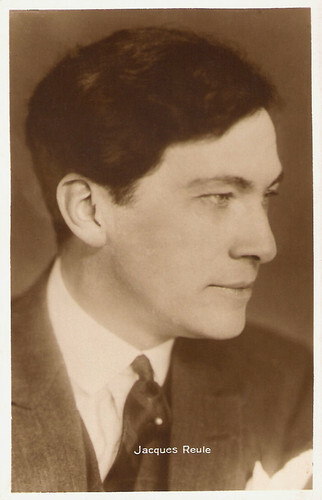
Dutch postcard by Weenenk & Snel, Den Haag. Photo: Willem Coret.
Jacques Reule (1879-1954) was a Dutch stage actor who occasionally played in Dutch films as well. He acted in two Dutch silent films, Pro Domo (Theo Frenkel, 1918) and De duivel in Amsterdam/The Devil in Amsterdam (Theo Frenkel, 1919), and one Dutch sound film, Blokkade/Block cade (Willem de Hoog, 1934).
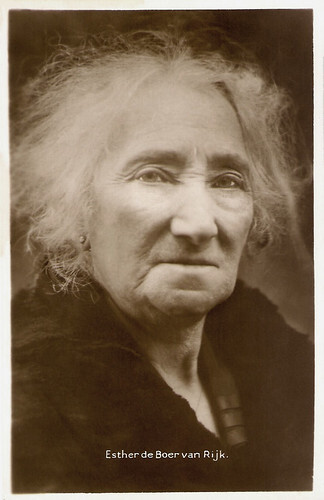
Dutch postcard by Weenenk & Snel, Den Haag. Photo: Willem Coret.
Esther de Boer-van Rijk (1853-1937) was the most popular Dutch actress ever. She was a national icon as the tragic fisherwoman Kniertje in the stage classic 'Op hoop van zegen' (The Good Hope) by Herman Heijermans and played the role again in both a silent (1918) and a sound film version (1934). She also appeared in a dozen other Dutch silent films.
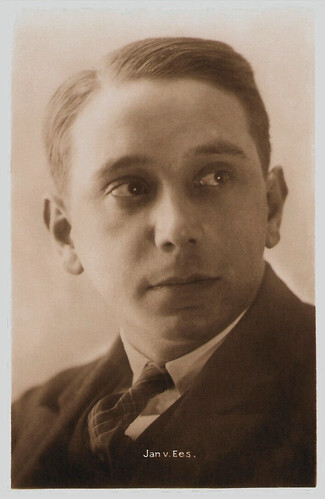
Dutch postcard by Uitgave Weenenk & Snel, Den Haag. Photo: Willem Coret.
Jan van Ees (1896-1966) was a popular Dutch actor, the author of several stage plays, and the brother of Annie van Ees. He was one of the title characters of the Dutch film classic De Jantjes/The Tars (Jaap Speyer, 1934) and starred in several other Dutch films of the 1930s.
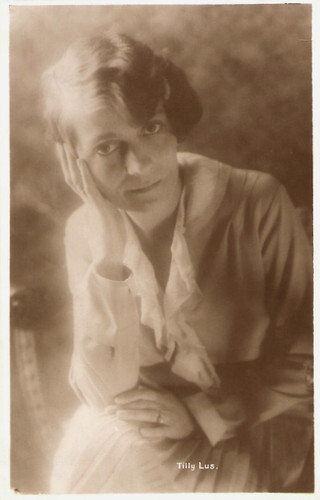
Dutch postcard by Weenenk & Snel, Den Haag (The Hague). Photo: Willem Coret.
Tilly Lus (1888-1971) was one of the great tragedy actresses of Dutch theatre. She also appeared in five silent films, including the first Dutch horror thriller Het Geheim van het Slot Arco/The Secret of Arco Castle (Maurits Binger, Jan van Dommelen, 1915), a Hollandia Filmfabriek production, filmed in Austria.
Hollywood in Holland
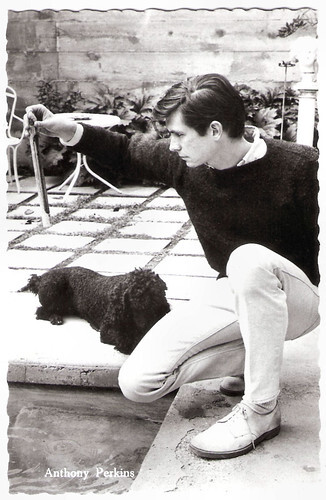
Dutch postcard by N.V. v.h. Weenenk & Snel, Baarn, no. 861.
Tall and slim American actor Anthony 'Tony' Perkins (1932-1992) is best known for his boyish good looks and his nervous, sweet but often unbalanced characters. Perkins made his screen debut in The Actress (1953) featuring Jean Simmons and was nominated for a Best Supporting Actor Oscar for his second film, the Civil War film Friendly Persuasion (1956). Three years later, he appeared in what would be his most memorable role to date, Norman Bates in Psycho (Alfred Hitchcock, 1960) and later in its three sequels.
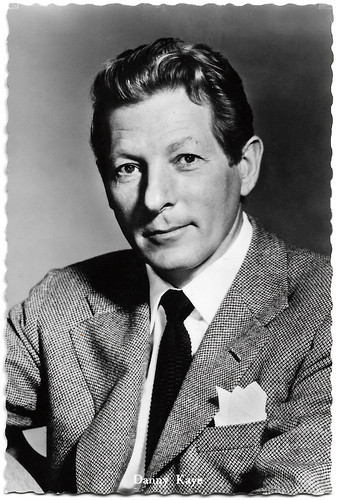
Dutch postcard by N.V. v.h. Weenenk & Snel, Baarn, no. 1060. Photo: M.G.M. Danny Kaye in Merry Andrew (Michael Kidd, 1958). Collection: Geoffrey Donaldson Institute.
Danny Kaye (1911-1987) was an American actor, singer, dancer, comedian, and musician. His performances featured physical comedy, idiosyncratic pantomimes, and tongue-twisting songs. Kaye starred in 17 films like Wonder Man (1945), The Secret Life of Walter Mitty (1947), and White Christmas (1954).
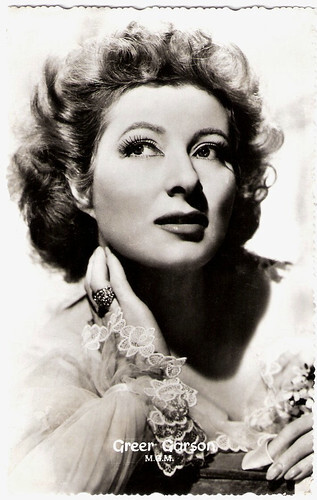
Dutch postcard by Weenenk & Snel, Baarn, no. 1155. Photo: MGM.
British-born actress Greer Garson (1904-1996) was a very popular Hollywood star during World War II. She epitomized a noble, wise, and courageous wife in sleek and sentimental films, often with Walter Pidgeon as her co-star. As one of MGM's major stars of the 1940s, Garson received seven Academy Award nominations. She won the Oscar for Mrs. Miniver (1942), in which she personified the spirit and virtue of a British homemaker in wartime.
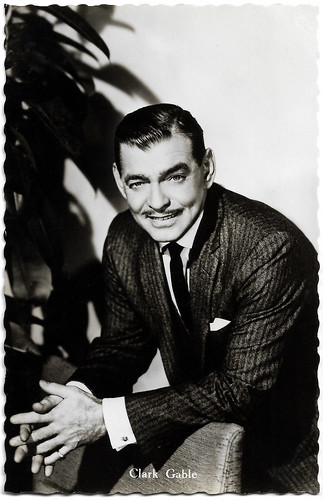
Dutch postcard by N.V. v.h. Weenenk & Snel, Baarn, no. 160 (?). Photo: Paramount. Clark Gable in But Not For Me (Walter Lang, 1959). Collection: Geoffrey Donaldson Institute.
With his natural charm and knowing smile, Clark Gable (1901-1959) was 'The King of Hollywood' during the 1930s. He often portrayed down-to-earth, bravado characters with a carefree attitude, and was seen as the epitome of masculinity. Gable won an Academy Award for Best Actor for It Happened One Night (1934), and was nominated for leading roles in Mutiny on the Bounty (1935) and for his best-known role as Rhett Butler in Gone with the Wind (1939).
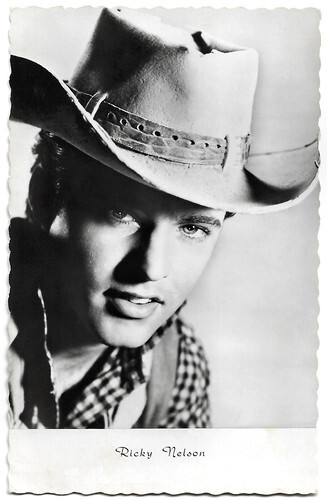
Dutch postcard by N.V. v. h. Weenenk & Snel, Baarn. Ricky Nelson in Rio Bravo (Howard Hawks, 1959).
American singer Ricky Nelson (1940-1985) was one of the first teenage stars in America. He started his career in his parents' television series The Adventures of Ozzie & Harriet. In the late 1950s, he had such hits as 'Hello Mary Lou' and he starred in the Western Rio Bravo (1959) with John Wayne.
European film stars
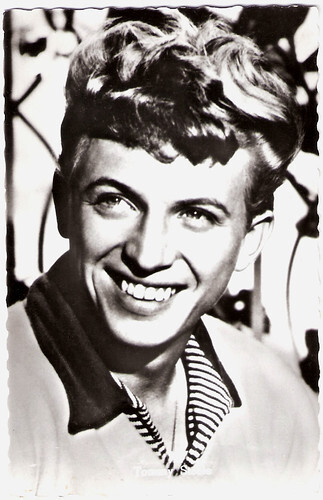
Dutch postcard by N.V. v.h. Weenenk & Snel, Baarn, no. 161. Photo: Centra.
Entertainer Tommy Steele (1936) was Britain's first teen idol and rock 'n roll star. His cheeky Cockney image and boy-next-door looks won him success as a musician, singer, and actor.
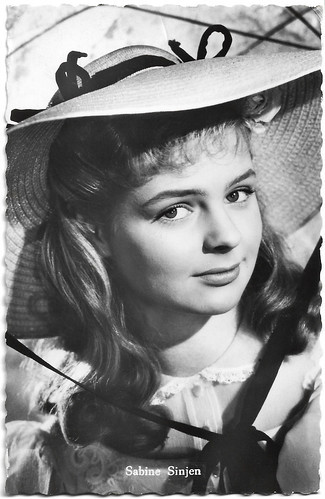
Dutch postcard by N.V. v.h. Weenenk & Snel, Baarn, no. 306. Sabine Sinjen in Alt Heidelberg/Old Heidelberg (Ernst Marischka, 1959). Collection: Geoffrey Donaldson Institute.
German Stage and film actress Sabine Sinjen (1942-1995) was a teenage star of the 1950s, who became a protagonist of the Neue Deutsche Film in the 1960s.
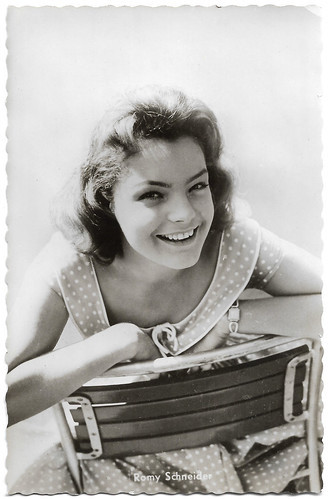
Dutch postcard by N.V. v.h. Weenenk & Snel, Baarn, no. 759 (?). Collection: Geoffrey Donaldson Institute.
Austrian actress Romy Schneider (1938-1982) was one of the most beautiful and intelligent actors of her generation. Thirty years after her death she still has an immense popular appeal.
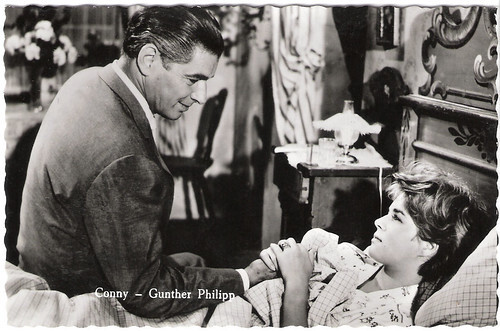
Dutch postcard by N.V. v.h. Weenenk & Snel, Baarn. Photo: Cornelia Froboess in Mariandl (Werner Jacobs, 1961). The man on the postcard is not the mentioned Günther Philipp but Rudolf Prack .
Cornelia Froboess (1943) was a teen idol in the late 1950s and early 1960s who would later become a respected stage actress. Austrian actor Rudolf Prack (1905-1981) was once 'the most often kissed man of the German cinema’. Nowadays he is mainly connected with his Heimatfilms of the 1950s, but his career already started in the middle of the 1930s.
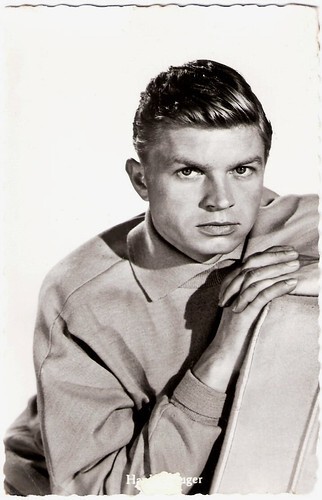
Dutch postcard by NV v.h. Weenenk & Snel, Baarn, no. 759. Photo: Rank Organisation. Hardy Krüger in The One That Got Away (Roy Ward Baker, 1957).
German actor and writer Hardy Krüger (1928-2022) was a blond heartthrob who acted in numerous European films of the 1950s and 1960s and also in several classic American films. He played friendly soldiers and adventurers in numerous German, British and French films and also in some Hollywood classics. Although he often was typecasted as the Aryan Nazi, he hated wearing the brown uniform.
Miscellaneous
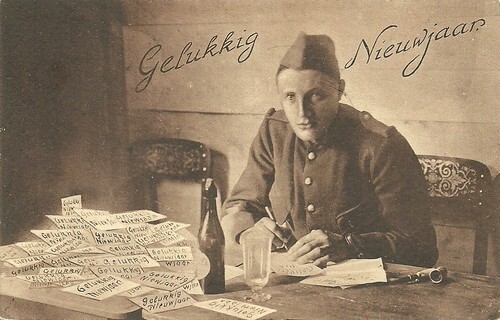
Dutch postcard by Weenenk & Snel, The Hague, no. 14 71448. Postcard mailed in 1921. Caption: Happy New Year.
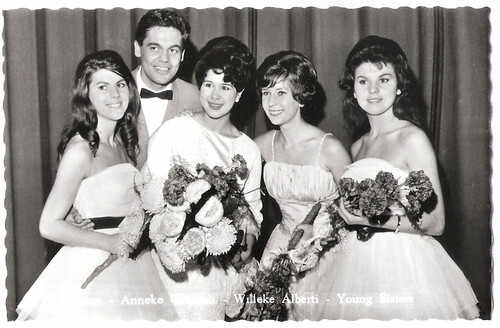
Dutch postcard by N.V. v.h. Weenenk & Snel, Baarn, no. 963. Photo: Phonogram / Philips. Dutch pop stars Johnny Lion , Anneke Grönloh, Willeke Alberti and The Young Sisters.
Source: Lodewijk van Duuren (VDP - Dutch).

Dutch postcard by Uitg. N.V. v.h. Weenenk & Snel, Baarn, no. 133.
Beautiful Myléne Demongeot (1936) became in 1957 one of the blond sex symbols of the French cinema when she seduced Yves Montand in Les sorcières de Salem. The coquettish French actress would go on to co-star in the three Fantômas adventures and many other European films of the 1950s and 1960s. In the 1980s she also became a producer.

Dutch postcard by N.V. v.h. Weenenk & Snel, Baarn, no. 661. Photo: MGM. Steve Reeves in Morgan il pirata/Morgan the Pirate (André De Toth, Primo Zeglio, 1960).
Handsome, musclebound Steve Reeves (1926-2000) was an American bodybuilder and actor, who was a huge success in Hercules (1958) and other Peplum films, the Italian sword-and-sandal epics. At the peak of his career, around 1960, he was reputedly the highest-paid actor in Europe.

Dutch postcard by N.V. v.h. Weenenk & Snel, Baarn, no. 761. Photo: Gofilex. Heidi Brühl in Immer will ich dich gehören/Always I will be yours (Arno Assmann, 1960) with Peter Weck .
Blonde, blue-eyed schlager singer and film star Heidi Brühl (1942-1991) was called 'the Doris Day of Germany'. In 1963 she was the German participant at the Eurovision Song Contest.

Dutch postcard by N.V. v.h. Weenenk & Snel, Baarn, no. 762. Photo: Günther Philipp, Conny Froboess and Peter Weck in Mariandl (Werner Jacobs, 1961).
Cornelia Froboess (1943) was as 'Conny' a teen idol in the late 1950s and early 1960s. Later she became a respected stage actress. Austrian actor, theatre impresario, and director Peter Weck (1930) appeared in more than 100 films. With his natural acting style in costume dramas and Heimatfilms, he became the Golden Boy from Vienna.

Dutch postcard by N.V. v.h. Weenenk & Snel, Baarn, no. 853. Photo: Hafbo-film. Anna Karina in Le soleil dans l'oeil/Sun in Your Eyes (Jacques Bourdon, 1962).
French, but Danish-born film actress, singer, and director Anna Karina (1940-2019) was the queen of the Nouvelle Vague. Karina was the muse of director Jean-Luc Godard and starred in eight of his films.
Dutch actors

Dutch postcard by Weenenk & Snel, Den Haag. Photo: Willem Coret, Den Haag (The Hague).
Dutch actress Annie van Ees (1893-1970) performed hundreds of times in the stage play 'Boefje' (Little Rascal, 1922). Boefje is a little street boy who is always into mischief but has a heart of gold. In 1935 Annie had already played 'Boefje' 500 times, often together with her husband, stage director Cor van der Lugt Melsert. When Van Ees was 45 and mother, she starred again as Boefje in a Dutch film after the play, Boefje (1939), directed by Detlev Sierck, the future Douglas Sirk.

Dutch postcard by Weenenk & Snel, Den Haag. Photo: Willem Coret. Collection: Geoffrey Donaldson Institute.
Dutch actor Eduard Verkade (1878-1961) was one of the actor-directors who revolutionised Dutch theatre in the first decades of the 20th century. He also starred in Dutch films of the 1910s, 1920s, and 1930s.

Dutch postcard by Weenenk & Snel, Den Haag. Photo: Willem Coret.
Jacques Reule (1879-1954) was a Dutch stage actor who occasionally played in Dutch films as well. He acted in two Dutch silent films, Pro Domo (Theo Frenkel, 1918) and De duivel in Amsterdam/The Devil in Amsterdam (Theo Frenkel, 1919), and one Dutch sound film, Blokkade/Block cade (Willem de Hoog, 1934).

Dutch postcard by Weenenk & Snel, Den Haag. Photo: Willem Coret.
Esther de Boer-van Rijk (1853-1937) was the most popular Dutch actress ever. She was a national icon as the tragic fisherwoman Kniertje in the stage classic 'Op hoop van zegen' (The Good Hope) by Herman Heijermans and played the role again in both a silent (1918) and a sound film version (1934). She also appeared in a dozen other Dutch silent films.

Dutch postcard by Uitgave Weenenk & Snel, Den Haag. Photo: Willem Coret.
Jan van Ees (1896-1966) was a popular Dutch actor, the author of several stage plays, and the brother of Annie van Ees. He was one of the title characters of the Dutch film classic De Jantjes/The Tars (Jaap Speyer, 1934) and starred in several other Dutch films of the 1930s.

Dutch postcard by Weenenk & Snel, Den Haag (The Hague). Photo: Willem Coret.
Tilly Lus (1888-1971) was one of the great tragedy actresses of Dutch theatre. She also appeared in five silent films, including the first Dutch horror thriller Het Geheim van het Slot Arco/The Secret of Arco Castle (Maurits Binger, Jan van Dommelen, 1915), a Hollandia Filmfabriek production, filmed in Austria.
Hollywood in Holland

Dutch postcard by N.V. v.h. Weenenk & Snel, Baarn, no. 861.
Tall and slim American actor Anthony 'Tony' Perkins (1932-1992) is best known for his boyish good looks and his nervous, sweet but often unbalanced characters. Perkins made his screen debut in The Actress (1953) featuring Jean Simmons and was nominated for a Best Supporting Actor Oscar for his second film, the Civil War film Friendly Persuasion (1956). Three years later, he appeared in what would be his most memorable role to date, Norman Bates in Psycho (Alfred Hitchcock, 1960) and later in its three sequels.

Dutch postcard by N.V. v.h. Weenenk & Snel, Baarn, no. 1060. Photo: M.G.M. Danny Kaye in Merry Andrew (Michael Kidd, 1958). Collection: Geoffrey Donaldson Institute.
Danny Kaye (1911-1987) was an American actor, singer, dancer, comedian, and musician. His performances featured physical comedy, idiosyncratic pantomimes, and tongue-twisting songs. Kaye starred in 17 films like Wonder Man (1945), The Secret Life of Walter Mitty (1947), and White Christmas (1954).

Dutch postcard by Weenenk & Snel, Baarn, no. 1155. Photo: MGM.
British-born actress Greer Garson (1904-1996) was a very popular Hollywood star during World War II. She epitomized a noble, wise, and courageous wife in sleek and sentimental films, often with Walter Pidgeon as her co-star. As one of MGM's major stars of the 1940s, Garson received seven Academy Award nominations. She won the Oscar for Mrs. Miniver (1942), in which she personified the spirit and virtue of a British homemaker in wartime.

Dutch postcard by N.V. v.h. Weenenk & Snel, Baarn, no. 160 (?). Photo: Paramount. Clark Gable in But Not For Me (Walter Lang, 1959). Collection: Geoffrey Donaldson Institute.
With his natural charm and knowing smile, Clark Gable (1901-1959) was 'The King of Hollywood' during the 1930s. He often portrayed down-to-earth, bravado characters with a carefree attitude, and was seen as the epitome of masculinity. Gable won an Academy Award for Best Actor for It Happened One Night (1934), and was nominated for leading roles in Mutiny on the Bounty (1935) and for his best-known role as Rhett Butler in Gone with the Wind (1939).

Dutch postcard by N.V. v. h. Weenenk & Snel, Baarn. Ricky Nelson in Rio Bravo (Howard Hawks, 1959).
American singer Ricky Nelson (1940-1985) was one of the first teenage stars in America. He started his career in his parents' television series The Adventures of Ozzie & Harriet. In the late 1950s, he had such hits as 'Hello Mary Lou' and he starred in the Western Rio Bravo (1959) with John Wayne.
European film stars

Dutch postcard by N.V. v.h. Weenenk & Snel, Baarn, no. 161. Photo: Centra.
Entertainer Tommy Steele (1936) was Britain's first teen idol and rock 'n roll star. His cheeky Cockney image and boy-next-door looks won him success as a musician, singer, and actor.

Dutch postcard by N.V. v.h. Weenenk & Snel, Baarn, no. 306. Sabine Sinjen in Alt Heidelberg/Old Heidelberg (Ernst Marischka, 1959). Collection: Geoffrey Donaldson Institute.
German Stage and film actress Sabine Sinjen (1942-1995) was a teenage star of the 1950s, who became a protagonist of the Neue Deutsche Film in the 1960s.

Dutch postcard by N.V. v.h. Weenenk & Snel, Baarn, no. 759 (?). Collection: Geoffrey Donaldson Institute.
Austrian actress Romy Schneider (1938-1982) was one of the most beautiful and intelligent actors of her generation. Thirty years after her death she still has an immense popular appeal.

Dutch postcard by N.V. v.h. Weenenk & Snel, Baarn. Photo: Cornelia Froboess in Mariandl (Werner Jacobs, 1961). The man on the postcard is not the mentioned Günther Philipp but Rudolf Prack .
Cornelia Froboess (1943) was a teen idol in the late 1950s and early 1960s who would later become a respected stage actress. Austrian actor Rudolf Prack (1905-1981) was once 'the most often kissed man of the German cinema’. Nowadays he is mainly connected with his Heimatfilms of the 1950s, but his career already started in the middle of the 1930s.

Dutch postcard by NV v.h. Weenenk & Snel, Baarn, no. 759. Photo: Rank Organisation. Hardy Krüger in The One That Got Away (Roy Ward Baker, 1957).
German actor and writer Hardy Krüger (1928-2022) was a blond heartthrob who acted in numerous European films of the 1950s and 1960s and also in several classic American films. He played friendly soldiers and adventurers in numerous German, British and French films and also in some Hollywood classics. Although he often was typecasted as the Aryan Nazi, he hated wearing the brown uniform.
Miscellaneous

Dutch postcard by Weenenk & Snel, The Hague, no. 14 71448. Postcard mailed in 1921. Caption: Happy New Year.

Dutch postcard by N.V. v.h. Weenenk & Snel, Baarn, no. 963. Photo: Phonogram / Philips. Dutch pop stars Johnny Lion , Anneke Grönloh, Willeke Alberti and The Young Sisters.
Source: Lodewijk van Duuren (VDP - Dutch).
Published on May 14, 2022 22:00
May 13, 2022
Written by Charles Dickens
Charles Dickens (1812-1870) was one of the most important English writers during the Victorian era and the first literary chronicler of the metropolis in the midst of the Industrial Revolution. He became famous with 'The Pickwick Papers', which appeared monthly from 1836 onwards. It was followed by 'Oliver Twist' in 1837-1838, 'Nicholas Nickleby' in 1838-1839, 'The Old Curiosity Shop' and 'Barnaby Rudge', both in 1841. Other famous novels are the partly autobiographical 'David Copperfield' (1849-1850), 'Great Expectations' (1860-1861), and 'A Christmas Carol' (1843). 'A Tale of Two Cities' is the world's seventh best-selling book with 200 million copies. His last novel, "The Mystery of Edwin Drood", was never completed and was later published posthumously. Characteristics of Dickens' stories are the social evils, the story structure, the cartoonish characters, and the humour. The first feature-length film adaptation was a 1913 version of 'David Copperfield' directed by Thomas Bentley for producer Cecil Hepworth. In the years since the prolific author has never ceased to be an inspiration for filmmakers—dozens of adaptations of his work have made their way to the screen.
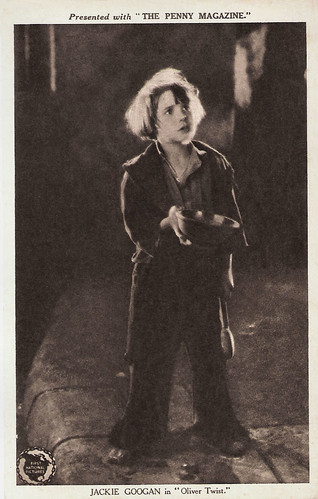
British postcard presented with The Penny Magazine. Photo: First National. Jackie Coogan in Oliver Twist (Frank Lloyd, 1922).
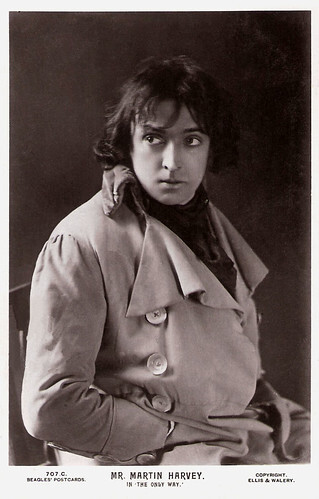
British postcard by Beagles Postcards, no. 707 C. Photo: Ellis & Walery. British Actor-manager Sir John Martin Harvey (1863-1944) was one of the last great romantic actors of the English theatre. His most famous play was 'The Only Way' (1899), an adaptation of Charles Dickens' 'A Tale of Two Cities'. 25 years later, he also featured in the film version when he was a sprightly 62 year-old.
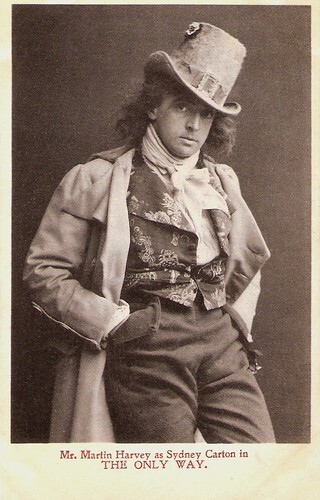
British postcard by the London Stereoscope Company. Photo: John Martin Harvey in The Only Way.
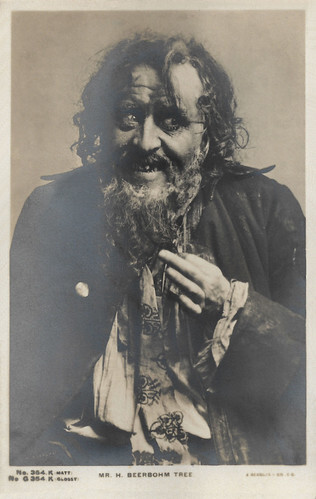
British postcard by J. Beagles & Co., London, no. 354. Photo: F.W. Burford. Herbert Beerbohm Tree as Fagin in 'Oliver Twist' by Charles Dickens.
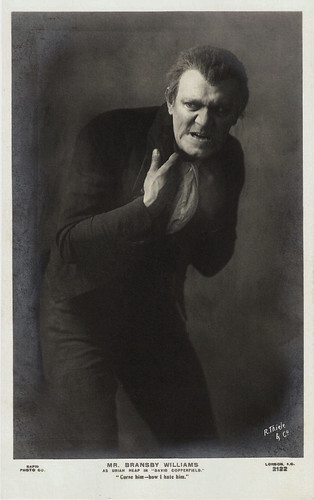
British postcard by Rapid Photo co., London, no. 3122 Photo: R. Thiele & Co. Publicity still for a stage production of David Copperfield with Bransby Williams as Uriah Heep. Caption: "Curse him - how I hate him." British comic actor and writer Bransby Williams (1870-1961) was on stage from the 1890s and often worked as a monologist and impersonator. From 1911 on, he played roles in more than 20 films. He is best known for his portraying various Charles Dickens characters.
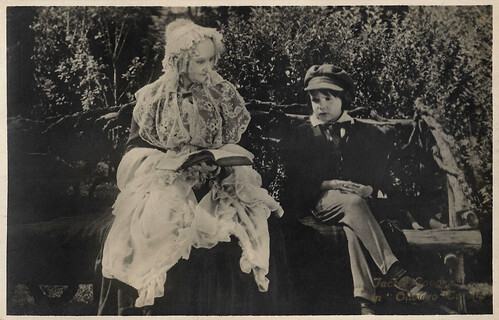
Italian postcard by Fotominio / G. B. Falci, Milano. Photo: Jackie Coogan in Oliver Twist (Frank Lloyd, 1922).
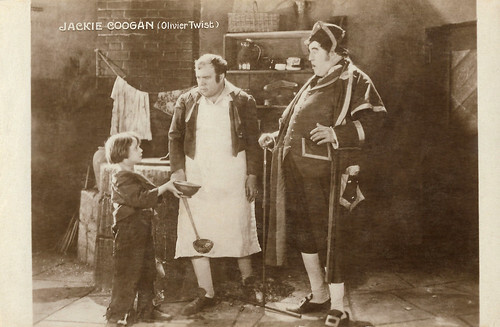
French postcard by Cinémagazine-Edition. Photo: Jackie Coogan in Oliver Twist (Frank Lloyd, 1922).
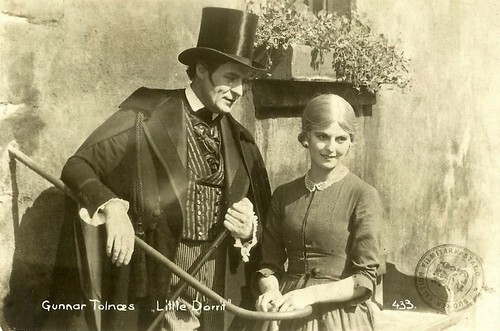
Finnish postcard, no. 433. The postcard carries a stamp from the Finnish film inspection office. Photo: Karina Bell as Little Dorrit and Gunnar Tolnaes as Arthur Clennam in the Charles Dickens adaptation Lille Dorritt/Little Dorrit (A.W. Sandberg, 1924), Dickens's rags-to-riches (and over again) story of a woman raised in a debtor's prison and her complex, fascinating life.

German postcard by Ross Verlag, no. 8717, 1933-1934. Photo: Ondra-Lamac-Film. Anny Ondra in Klein Dorrit/Little Dorrit (Carl Lamac, 1934).
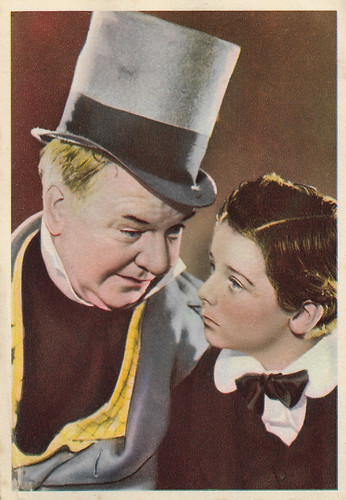
British postcard by De Reszke Cigarettes, no. 6. Photo: Metro-Goldwyn-Mayer (MGM). W.C. Fields and Freddie Bartholomew in David Copperfield (George Cukor, 1935). This George Cukor adaptation makes exceptional work of condensing the story down to just over two hours. Full of enthusiastic turns from 'big' actors, particularly W.C. Fields as Mr. Micawber.
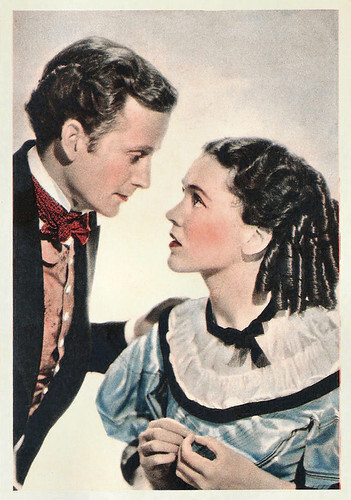
British postcard for Abdulla Cigarettes, no. 38. Photo: M.G.M. Frank Lawton and Maureen O'Sullivan in David Copperfield (George Cukor, 1935).

British postcard by Rotary Photo, London, no. F.S. 18. Caption: John Mills with his small daughter 'Bunch' (Juliet Mills) in the studio. The picture was taken during the shooting of Great Expectations (David Lean, 1946). At the time, Bunch must have been four years old.
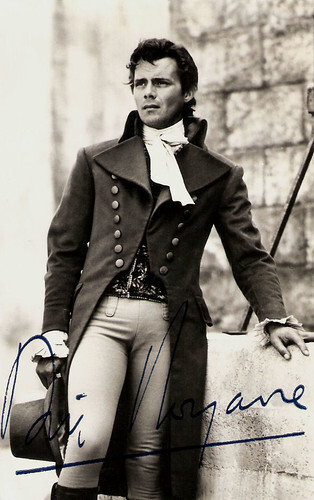
British postcard. Photo: Rank. Dirk Bogarde in A Tale of Two Cities (Ralph Thomas, 1958), set in London and Paris in the lead up to the French Revolution. The task of adapting this notoriously difficult story was given to T.E.B. Clarke, best remembered as a writer of Ealing comedies. The role of Sydney Carton, the drunken lawyer who becomes a self-sacrificing melodramatic hero, was played by Dirk Bogarde at the height of his matinee-idol fame.
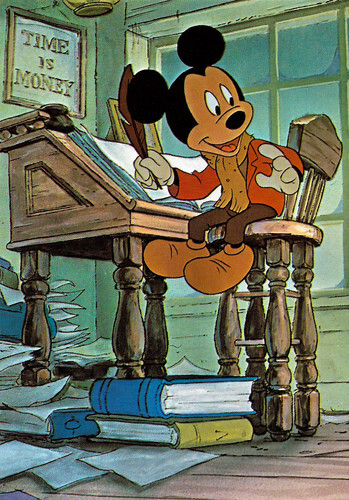
Italian postcard by Grafiche Biondetti srl, Verona, no. 133/4. Illustration: Walt Disney Productions. Film image of Mickey's Christmas Carol (Burny Mattinson, 1983). At 26 minutes Mickey's Christmas Carol is technically a short, but it was released in cinemas, so we're having it. Scrooge McDuck obviously takes the role of Ebeneezer Scrooge, with beloved Disney characters making up the rest of the cast. The animation is beautiful and the Disney humour marries well with Dickens' story.

French postcard by MB, Paris, no. D 640, 5/4. Image: Disney. Publicity still for Oliver & Co. (1988). Oliver & Company (George Scribner, 1988) is the twenty-seventh animated feature released in the Disney Canon. It was inspired by Charles Dickens's 'Oliver Twist' (1838).
Sources: Liz Cantrell and Adam Rathe (Town & Country), Wikipedia (Dutch), and .

British postcard presented with The Penny Magazine. Photo: First National. Jackie Coogan in Oliver Twist (Frank Lloyd, 1922).

British postcard by Beagles Postcards, no. 707 C. Photo: Ellis & Walery. British Actor-manager Sir John Martin Harvey (1863-1944) was one of the last great romantic actors of the English theatre. His most famous play was 'The Only Way' (1899), an adaptation of Charles Dickens' 'A Tale of Two Cities'. 25 years later, he also featured in the film version when he was a sprightly 62 year-old.

British postcard by the London Stereoscope Company. Photo: John Martin Harvey in The Only Way.

British postcard by J. Beagles & Co., London, no. 354. Photo: F.W. Burford. Herbert Beerbohm Tree as Fagin in 'Oliver Twist' by Charles Dickens.

British postcard by Rapid Photo co., London, no. 3122 Photo: R. Thiele & Co. Publicity still for a stage production of David Copperfield with Bransby Williams as Uriah Heep. Caption: "Curse him - how I hate him." British comic actor and writer Bransby Williams (1870-1961) was on stage from the 1890s and often worked as a monologist and impersonator. From 1911 on, he played roles in more than 20 films. He is best known for his portraying various Charles Dickens characters.

Italian postcard by Fotominio / G. B. Falci, Milano. Photo: Jackie Coogan in Oliver Twist (Frank Lloyd, 1922).

French postcard by Cinémagazine-Edition. Photo: Jackie Coogan in Oliver Twist (Frank Lloyd, 1922).

Finnish postcard, no. 433. The postcard carries a stamp from the Finnish film inspection office. Photo: Karina Bell as Little Dorrit and Gunnar Tolnaes as Arthur Clennam in the Charles Dickens adaptation Lille Dorritt/Little Dorrit (A.W. Sandberg, 1924), Dickens's rags-to-riches (and over again) story of a woman raised in a debtor's prison and her complex, fascinating life.

German postcard by Ross Verlag, no. 8717, 1933-1934. Photo: Ondra-Lamac-Film. Anny Ondra in Klein Dorrit/Little Dorrit (Carl Lamac, 1934).

British postcard by De Reszke Cigarettes, no. 6. Photo: Metro-Goldwyn-Mayer (MGM). W.C. Fields and Freddie Bartholomew in David Copperfield (George Cukor, 1935). This George Cukor adaptation makes exceptional work of condensing the story down to just over two hours. Full of enthusiastic turns from 'big' actors, particularly W.C. Fields as Mr. Micawber.

British postcard for Abdulla Cigarettes, no. 38. Photo: M.G.M. Frank Lawton and Maureen O'Sullivan in David Copperfield (George Cukor, 1935).

British postcard by Rotary Photo, London, no. F.S. 18. Caption: John Mills with his small daughter 'Bunch' (Juliet Mills) in the studio. The picture was taken during the shooting of Great Expectations (David Lean, 1946). At the time, Bunch must have been four years old.

British postcard. Photo: Rank. Dirk Bogarde in A Tale of Two Cities (Ralph Thomas, 1958), set in London and Paris in the lead up to the French Revolution. The task of adapting this notoriously difficult story was given to T.E.B. Clarke, best remembered as a writer of Ealing comedies. The role of Sydney Carton, the drunken lawyer who becomes a self-sacrificing melodramatic hero, was played by Dirk Bogarde at the height of his matinee-idol fame.

Italian postcard by Grafiche Biondetti srl, Verona, no. 133/4. Illustration: Walt Disney Productions. Film image of Mickey's Christmas Carol (Burny Mattinson, 1983). At 26 minutes Mickey's Christmas Carol is technically a short, but it was released in cinemas, so we're having it. Scrooge McDuck obviously takes the role of Ebeneezer Scrooge, with beloved Disney characters making up the rest of the cast. The animation is beautiful and the Disney humour marries well with Dickens' story.

French postcard by MB, Paris, no. D 640, 5/4. Image: Disney. Publicity still for Oliver & Co. (1988). Oliver & Company (George Scribner, 1988) is the twenty-seventh animated feature released in the Disney Canon. It was inspired by Charles Dickens's 'Oliver Twist' (1838).
Sources: Liz Cantrell and Adam Rathe (Town & Country), Wikipedia (Dutch), and .
Published on May 13, 2022 22:00
May 12, 2022
Clara Bow
American actress Clara Bow (1905-1965) rose to stardom as an uninhibited flapper in silent films during the 1920s. Her appearance as a plucky shopgirl in the film It (1927) brought her global fame and the nickname 'The It Girl'. Bow came to personify the Roaring Twenties and is described as its leading sex symbol.
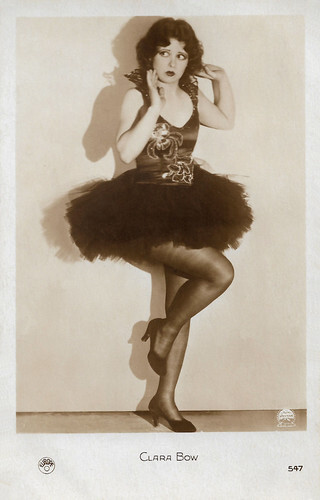
French postcard by Europe, no. 547. Photo: Paramount.

French postcard by Europe, no. 630. Photo: Paramount.

German postcard by Ross Verlag, no. 3510/1, 1928-1929. Photo: Paramount.

German postcard by Ross-Verlag, no. 3980/3, 1928-1929. Photo: Paramount.
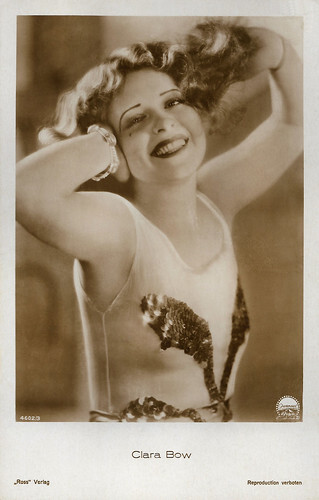
German postcard by Ross Verlag, no. 4602/3, 1929-1930. Photo: Paramount.
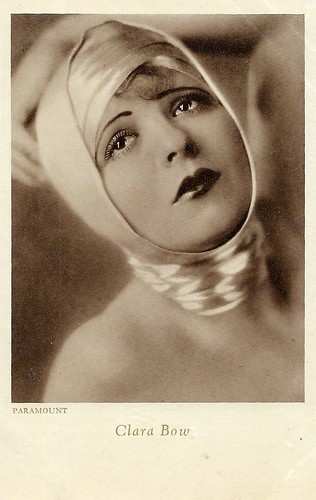
Italian postcard by Cinema-Illustrazione, series 1, no. 16. Photo: Paramount. Photo by George P. Hommel (1929).
The hottest jazz baby in films
Clara Gordon Bow was born in a run-down tenement in old Brooklyn in 1905 and was raised in poverty and violence. Her often absentee and brutish father, Robert Bow, who hailed from a large and once well-off family of Scottish and English descent, could not or did not provide.
Her schizophrenic mother, the former Sarah Gordon, tried to slit Clara's throat when the girl spoke of becoming an actress. Bow, nonetheless, Clara won a national photo beauty contest, "The Fame and Fortune Contest". Girls from all over the country competed, and the 1st Prize was a part in a film.
Bow showed up in ragged clothes and the other girls smirked at her. The contest judges paid no attention until she did her screen test - and then they unanimously chose her over all the other girls. Bow lit up the screen and got the part but it was later cut from the film. Clara was taken to Hollywood by independent producer B.P. Schulberg, who used her sexually and financially.
She would eventually star in 58 films, from 1922 to 1933. Schulberg billed her as "The Hottest Jazz Baby in Films" for The Plastic Age (Wesley Ruggles, 1925). Her other silent films included hits such as Mantrap (Victor Fleming, 1926), It (Clarence Badger, 1927), and Wings (William A. Wellman, 1927) with Charles 'Buddy' Rogers , Richard Arlen, and Gary Cooper . Denny Jackson at IMDb : "The movie It (1927) defined her career. The film starred Clara as a shopgirl who was asked out by the store's owner. As you watch the silent film you can see the excitement as she prepared for her date with the boss, her friend trying hard to assist her. She used a pair of scissors to modify her dress to try to look "sexier".
The movie did much to change society's mores as there were only a few years between World War I and Clara Bow, but this movie went a long way in how society looked at itself. Clara was flaming youth in rebellion. In the film, she presented worldly wisdom that somehow sex meant having a good time. But the movie shouldn't mislead the viewer, because when her boss tries to kiss her goodnight, she slaps him."

French postcard by Cinémagazine-Edition, Paris, no. 122. Photo: Paramount.
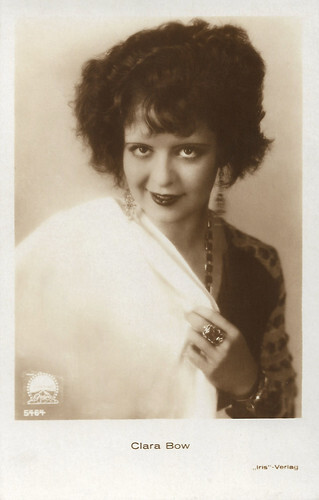
Austrian postcard by Iris Verlag, no. 5464. Photo: Paramount.
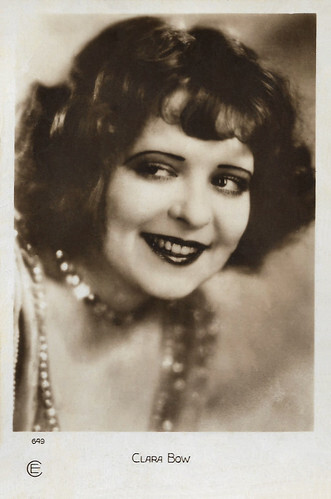
French postcard by Cinémagazine-Edition, Paris, no. 649.
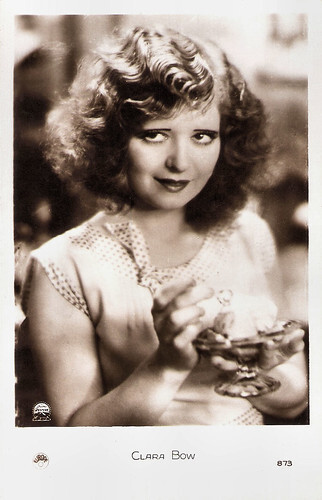
French postcard by Europe, no. 873. Photo: Paramount.
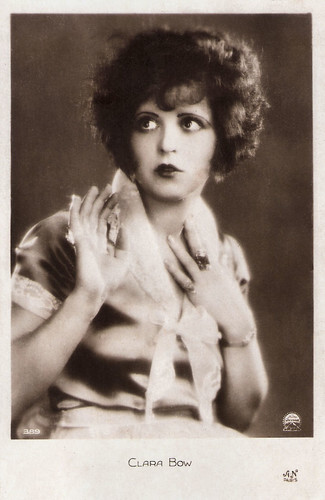
French postcard by A.N., Paris, no. 389. Photo: Paramount.
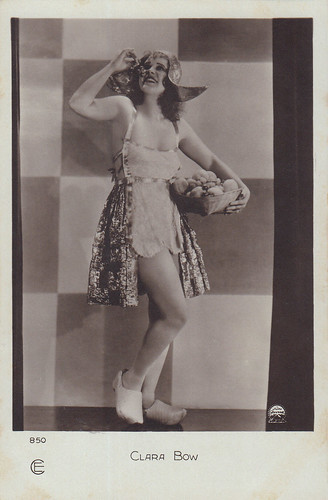
French postcard by Cinémagazine-Edition, Paris, no. 850. Photo: Films Paramount. Collection: Marlene Pilaete.
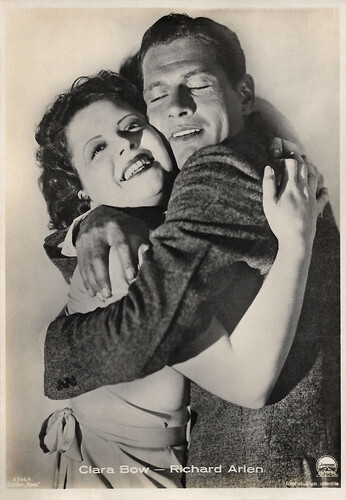
French postcard by Edition Ross, no. 4340/1, 1929-1930. Photo: Paramount. Clara Bow and Richard Arlen in Ladies of the Mob (William A. Wellman, 1928).
Flaming youth in rebellion
Clara Bow was named first box-office draw in 1928 and 1929 and second box-office draw in 1927 and 1930. Her presence in a motion picture was said to have ensured investors, by odds of almost 2-to-1, a 'safe return". Maeve at IMDb : "She could flirt with the camera just by looking into it with her big brown eyes and mischievous bow-tie grin. She exuded sex appeal from every pore in her little body and was not afraid to flaunt it. She personified "flaming youth in rebellion". Her characters were always working-class gals; manicurists, showgirls, and the like. Her movies reportedly emancipated many young people from the restrictive morals of their parents."
At the apex of her stardom, she received more than 45,000 fan letters in a single month (January 1929). Also, she was probably the most overworked and underpaid star in the industry. With the coming of sound, her popularity waned. Clara was also involved in several court battles ranging from unpaid taxes to "stealing" women's husbands. She had very public affairs (her euphemism was "engagements") with a score of leading men and directors, including Victor Fleming, Gary Cooper , and Gilbert Roland .
Her secretary and best friend, Daisy de Voe, was caught embezzling from her. Nasty rumors about her sexuality floated around the movie colony, including one about her taking on the entire USC Football Team one night, which was finally disproved by a biographer, David Stenn. When Bow took de Voe to court, the secretary told the court about and the press reported uncensored details of Bow's sex life, much of which was exaggerated.
After the court trials, Bow made a couple of attempts to get back in the public eye. One was Call Her Savage (John Francis Dillon, 1932), somewhat of a failure at the box office. In 1932, she married cowboy star Rex Bell and two years later, Bow retired from acting and became a rancher in Nevada. Her final film was Hoop-La (Frank Lloyd, 1933).
She doted on her two sons, actor Rex Bell Jr. (b. 1934) and George Robert (b. 1938), and did everything to please them. Haunted by a weight problem and a mental imbalance, she never re-entered show business. She was confined to sanitariums from time to time and prohibited access to her beloved sons. In 1965, Bow died of a heart attack in West Los Angeles at the age of 60.

German postcard by Ross Verlag, no. 533. Photo: Paramount.
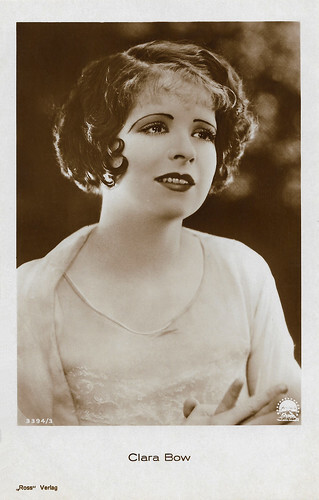
German postcard by Ross Verlag, no. 3394/3, 1928-1929. Photo: Paramount.
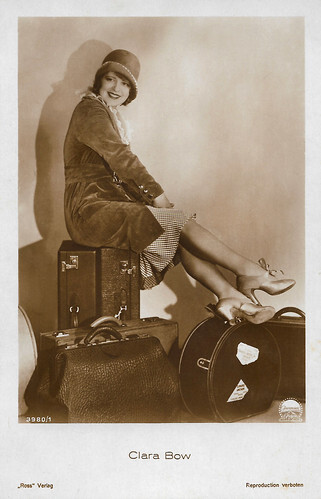
German postcard by Ross Verlag, no. 3980/1, 1928-1929. Photo: Paramount.
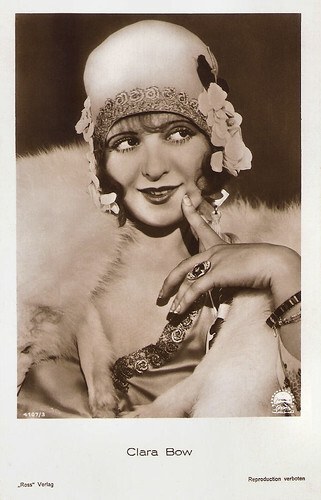
German postcard by Ross Verlag, no. 4107/3, 1929-1930. Photo: Paramount.
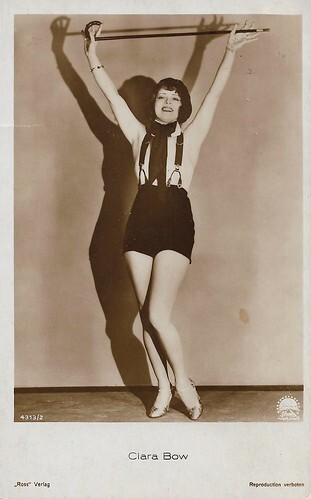
German postcard by Ross Verlag, no. 4313/2, 1929-1930. Photo: Paramount.

German postcard by Ross-Verlag, no. 4672/1, 1929-1930. Foto: Paramount.

German postcard by Ross-Verlag, no. 4672/3, 1928-1929. Photo: Paramount. Collection: Geoffrey Donaldson Institute.
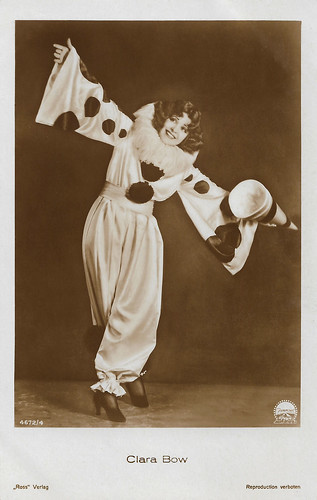
German postcard by Ross-Verlag, no. 4672/4, 1928-1929.
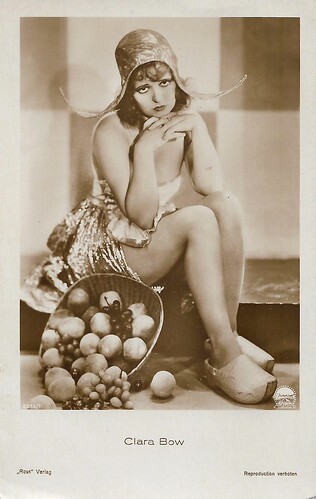
German postcard by Ross Verlag Berlin, no. 5393/1, 1930-1931. Photo: Paramount.
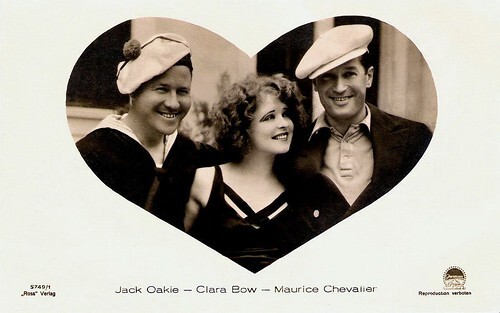
German postcard by Ross Verlag, no. 5749/1, 1930-1931. Photo: Paramount. Jack Oakie, Clara Bow, and Maurice Chevalier in Paramount on Parade (Dorothy Arzner a.o., 1930).
Sources: (IMDb), Wikipedia, and .

French postcard by Europe, no. 547. Photo: Paramount.

French postcard by Europe, no. 630. Photo: Paramount.

German postcard by Ross Verlag, no. 3510/1, 1928-1929. Photo: Paramount.

German postcard by Ross-Verlag, no. 3980/3, 1928-1929. Photo: Paramount.

German postcard by Ross Verlag, no. 4602/3, 1929-1930. Photo: Paramount.

Italian postcard by Cinema-Illustrazione, series 1, no. 16. Photo: Paramount. Photo by George P. Hommel (1929).
The hottest jazz baby in films
Clara Gordon Bow was born in a run-down tenement in old Brooklyn in 1905 and was raised in poverty and violence. Her often absentee and brutish father, Robert Bow, who hailed from a large and once well-off family of Scottish and English descent, could not or did not provide.
Her schizophrenic mother, the former Sarah Gordon, tried to slit Clara's throat when the girl spoke of becoming an actress. Bow, nonetheless, Clara won a national photo beauty contest, "The Fame and Fortune Contest". Girls from all over the country competed, and the 1st Prize was a part in a film.
Bow showed up in ragged clothes and the other girls smirked at her. The contest judges paid no attention until she did her screen test - and then they unanimously chose her over all the other girls. Bow lit up the screen and got the part but it was later cut from the film. Clara was taken to Hollywood by independent producer B.P. Schulberg, who used her sexually and financially.
She would eventually star in 58 films, from 1922 to 1933. Schulberg billed her as "The Hottest Jazz Baby in Films" for The Plastic Age (Wesley Ruggles, 1925). Her other silent films included hits such as Mantrap (Victor Fleming, 1926), It (Clarence Badger, 1927), and Wings (William A. Wellman, 1927) with Charles 'Buddy' Rogers , Richard Arlen, and Gary Cooper . Denny Jackson at IMDb : "The movie It (1927) defined her career. The film starred Clara as a shopgirl who was asked out by the store's owner. As you watch the silent film you can see the excitement as she prepared for her date with the boss, her friend trying hard to assist her. She used a pair of scissors to modify her dress to try to look "sexier".
The movie did much to change society's mores as there were only a few years between World War I and Clara Bow, but this movie went a long way in how society looked at itself. Clara was flaming youth in rebellion. In the film, she presented worldly wisdom that somehow sex meant having a good time. But the movie shouldn't mislead the viewer, because when her boss tries to kiss her goodnight, she slaps him."

French postcard by Cinémagazine-Edition, Paris, no. 122. Photo: Paramount.

Austrian postcard by Iris Verlag, no. 5464. Photo: Paramount.

French postcard by Cinémagazine-Edition, Paris, no. 649.

French postcard by Europe, no. 873. Photo: Paramount.

French postcard by A.N., Paris, no. 389. Photo: Paramount.

French postcard by Cinémagazine-Edition, Paris, no. 850. Photo: Films Paramount. Collection: Marlene Pilaete.

French postcard by Edition Ross, no. 4340/1, 1929-1930. Photo: Paramount. Clara Bow and Richard Arlen in Ladies of the Mob (William A. Wellman, 1928).
Flaming youth in rebellion
Clara Bow was named first box-office draw in 1928 and 1929 and second box-office draw in 1927 and 1930. Her presence in a motion picture was said to have ensured investors, by odds of almost 2-to-1, a 'safe return". Maeve at IMDb : "She could flirt with the camera just by looking into it with her big brown eyes and mischievous bow-tie grin. She exuded sex appeal from every pore in her little body and was not afraid to flaunt it. She personified "flaming youth in rebellion". Her characters were always working-class gals; manicurists, showgirls, and the like. Her movies reportedly emancipated many young people from the restrictive morals of their parents."
At the apex of her stardom, she received more than 45,000 fan letters in a single month (January 1929). Also, she was probably the most overworked and underpaid star in the industry. With the coming of sound, her popularity waned. Clara was also involved in several court battles ranging from unpaid taxes to "stealing" women's husbands. She had very public affairs (her euphemism was "engagements") with a score of leading men and directors, including Victor Fleming, Gary Cooper , and Gilbert Roland .
Her secretary and best friend, Daisy de Voe, was caught embezzling from her. Nasty rumors about her sexuality floated around the movie colony, including one about her taking on the entire USC Football Team one night, which was finally disproved by a biographer, David Stenn. When Bow took de Voe to court, the secretary told the court about and the press reported uncensored details of Bow's sex life, much of which was exaggerated.
After the court trials, Bow made a couple of attempts to get back in the public eye. One was Call Her Savage (John Francis Dillon, 1932), somewhat of a failure at the box office. In 1932, she married cowboy star Rex Bell and two years later, Bow retired from acting and became a rancher in Nevada. Her final film was Hoop-La (Frank Lloyd, 1933).
She doted on her two sons, actor Rex Bell Jr. (b. 1934) and George Robert (b. 1938), and did everything to please them. Haunted by a weight problem and a mental imbalance, she never re-entered show business. She was confined to sanitariums from time to time and prohibited access to her beloved sons. In 1965, Bow died of a heart attack in West Los Angeles at the age of 60.

German postcard by Ross Verlag, no. 533. Photo: Paramount.

German postcard by Ross Verlag, no. 3394/3, 1928-1929. Photo: Paramount.

German postcard by Ross Verlag, no. 3980/1, 1928-1929. Photo: Paramount.

German postcard by Ross Verlag, no. 4107/3, 1929-1930. Photo: Paramount.

German postcard by Ross Verlag, no. 4313/2, 1929-1930. Photo: Paramount.

German postcard by Ross-Verlag, no. 4672/1, 1929-1930. Foto: Paramount.

German postcard by Ross-Verlag, no. 4672/3, 1928-1929. Photo: Paramount. Collection: Geoffrey Donaldson Institute.

German postcard by Ross-Verlag, no. 4672/4, 1928-1929.

German postcard by Ross Verlag Berlin, no. 5393/1, 1930-1931. Photo: Paramount.

German postcard by Ross Verlag, no. 5749/1, 1930-1931. Photo: Paramount. Jack Oakie, Clara Bow, and Maurice Chevalier in Paramount on Parade (Dorothy Arzner a.o., 1930).
Sources: (IMDb), Wikipedia, and .
Published on May 12, 2022 22:00
May 11, 2022
Butywave Shampoo
"Butywave Shampoo - gives life to your hair", said a popular British advert in the 1920s: "Each shampoo contains in separate packets Egyptian Henna and Lime-Juice Rinsing Chrystals." This was a shampoo that loved an exotic image. When the smash hit The Son of the Sheik (George Fitzmaurice, 1926) with Rudolph Valentino and Vilma Banky arrived in Great Britain, Butywave released a series of sepia postcards of the film to promote its shampoo.
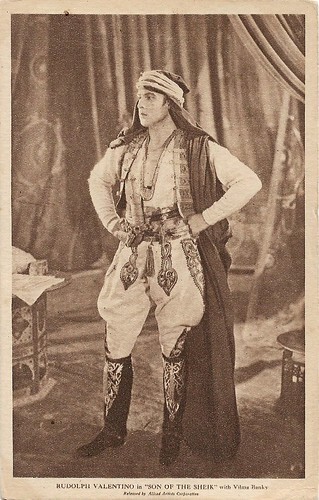
British postcard in a series by Shampoing Butywave. Photo: Allied Artists. Rudolph Valentino in The Son of the Sheik (George Fitzmaurice, 1926).
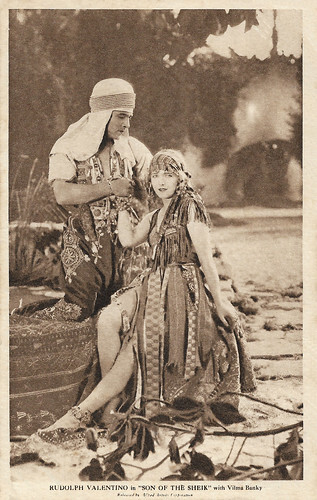
British postcard in a series by Shampoing Butywave. Photo: Allied Artists. Rudolph Valentino and Vilma Bánky in The Son of the Sheik (George Fitzmaurice, 1926).

British postcard in a series by Shampoing Butywave. Photo: Allied Artists. Rudolph Valentino and Vilma Banky in The Son of the Sheik (George Fitzmaurice, 1926).
Mass hysteria
The Butywave postcards were clearly not intended for a male audience while Rudolph Valentino 's hair was never revealed on the pictures.
Valentino's early death at age 31 caused mass hysteria among his female fans and propelled him into iconic status. The postcard series must have been a success while Butywave still exists today.
There were actually 32 cards in the series but in this post are only 9 of them. All cards have a top-three line wording saying “One of these beautiful reproductions of Rudolph Valentino `s love scenes is contained in every Butywave Shampoo Packet. 32 Scenes in All.
Each shampoo contains a different one. Note: If you buy 6 Butywave Shampoos you will be given a large Art Portrait (8 ins by 10 in) of Rudolph Valentino ready for framing, free. Ask for it at the shop”.
Then there are two lines of printed mock handwriting at the bottom which says: “P.S. I`ve fallen in love with Butywave Shampoo – have you?” Most cards are from The Son of The Sheik but one card is from Valentino's The Eagle (Clarence Brown, 1925), however not in this post.
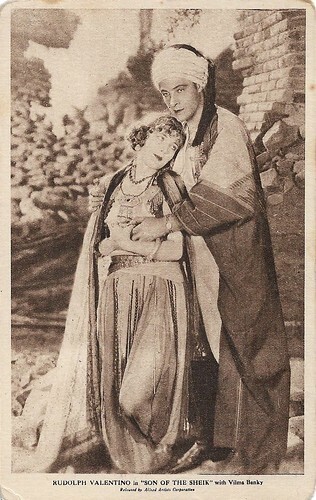
British postcard in a series by Shampoing Butywave. Photo: Allied Artists. Rudolph Valentino and Vilma Banky in The Son of the Sheik (George Fitzmaurice, 1926).
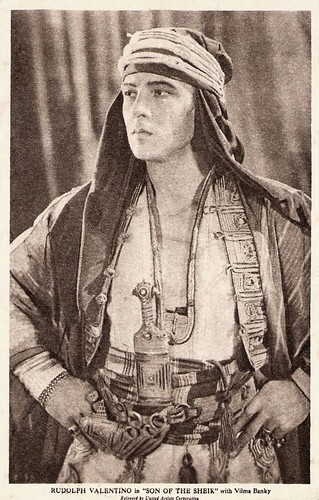
British postcard for Butywave Shampoo. Photo: United Artists. Rudolph Valentino in The Son of the Sheik (George Fitzmaurice, 1926).
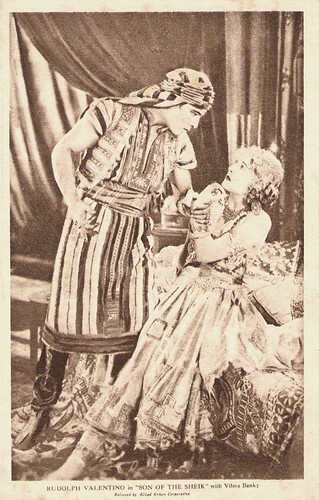
British postcard in a series by Shampoing Butywave. Photo: Allied Artists. Rudolph Valentino and Vilma Banky in The Son of the Sheik (George Fitzmaurice, 1926).
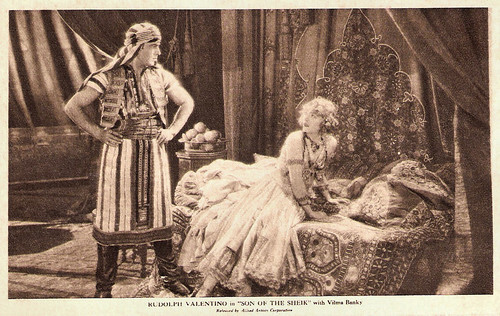
British postcard in a series by Shampoing Butywave. Photo: Allied Artists. Rudolph Valentino and Vilma Banky in The Son of the Sheik (George Fitzmaurice, 1926).
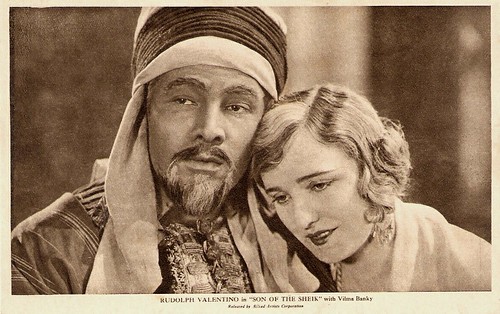
British postcard in a series by Shampoing Butywave. Photo: Allied Artists. Publicity still for The Son of the Sheik (1926). Despite the card telling this is Banky, the lady in question is Agnes Ayres . Ayres and Rudolph Valentino play the parents of the leading character, also played by Valentino. Actually the parents are the former protagonists of the earlier film The Sheik, now grown older.
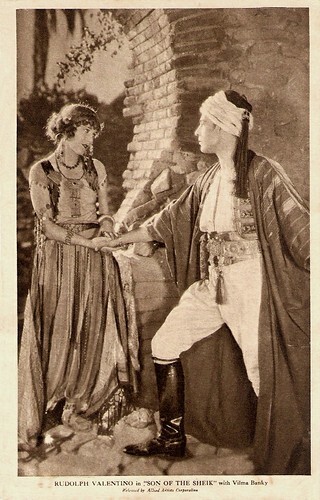
British postcard in a series by Shampoing Butywave. Photo: Allied Artists. Rudolph Valentino and Vilma Banky in The Son of the Sheik (George Fitzmaurice, 1926).
Source: Worthpoint, IMDb and the cards.

British postcard in a series by Shampoing Butywave. Photo: Allied Artists. Rudolph Valentino in The Son of the Sheik (George Fitzmaurice, 1926).

British postcard in a series by Shampoing Butywave. Photo: Allied Artists. Rudolph Valentino and Vilma Bánky in The Son of the Sheik (George Fitzmaurice, 1926).

British postcard in a series by Shampoing Butywave. Photo: Allied Artists. Rudolph Valentino and Vilma Banky in The Son of the Sheik (George Fitzmaurice, 1926).
Mass hysteria
The Butywave postcards were clearly not intended for a male audience while Rudolph Valentino 's hair was never revealed on the pictures.
Valentino's early death at age 31 caused mass hysteria among his female fans and propelled him into iconic status. The postcard series must have been a success while Butywave still exists today.
There were actually 32 cards in the series but in this post are only 9 of them. All cards have a top-three line wording saying “One of these beautiful reproductions of Rudolph Valentino `s love scenes is contained in every Butywave Shampoo Packet. 32 Scenes in All.
Each shampoo contains a different one. Note: If you buy 6 Butywave Shampoos you will be given a large Art Portrait (8 ins by 10 in) of Rudolph Valentino ready for framing, free. Ask for it at the shop”.
Then there are two lines of printed mock handwriting at the bottom which says: “P.S. I`ve fallen in love with Butywave Shampoo – have you?” Most cards are from The Son of The Sheik but one card is from Valentino's The Eagle (Clarence Brown, 1925), however not in this post.

British postcard in a series by Shampoing Butywave. Photo: Allied Artists. Rudolph Valentino and Vilma Banky in The Son of the Sheik (George Fitzmaurice, 1926).

British postcard for Butywave Shampoo. Photo: United Artists. Rudolph Valentino in The Son of the Sheik (George Fitzmaurice, 1926).

British postcard in a series by Shampoing Butywave. Photo: Allied Artists. Rudolph Valentino and Vilma Banky in The Son of the Sheik (George Fitzmaurice, 1926).

British postcard in a series by Shampoing Butywave. Photo: Allied Artists. Rudolph Valentino and Vilma Banky in The Son of the Sheik (George Fitzmaurice, 1926).

British postcard in a series by Shampoing Butywave. Photo: Allied Artists. Publicity still for The Son of the Sheik (1926). Despite the card telling this is Banky, the lady in question is Agnes Ayres . Ayres and Rudolph Valentino play the parents of the leading character, also played by Valentino. Actually the parents are the former protagonists of the earlier film The Sheik, now grown older.

British postcard in a series by Shampoing Butywave. Photo: Allied Artists. Rudolph Valentino and Vilma Banky in The Son of the Sheik (George Fitzmaurice, 1926).
Source: Worthpoint, IMDb and the cards.
Published on May 11, 2022 22:00
May 10, 2022
Bomben (1920)
Boyish good-looking Gösta Ekman and Karin Molander were the stars of the Swedish silent comedy Bomben/Sunshine and Shadow (Rune Carlsten, 1920). Skandia Film produced the film and the film was shot in the summer of 1919 in the Skandia studio in Långängen, the Claestorp estate in Södermanland, Sigtuna, Vaxholm, Stockholm and on the Jönköping-Gripenberg railway. Axel Eliassons Konstförlag published a series of delicious postcards of the film.
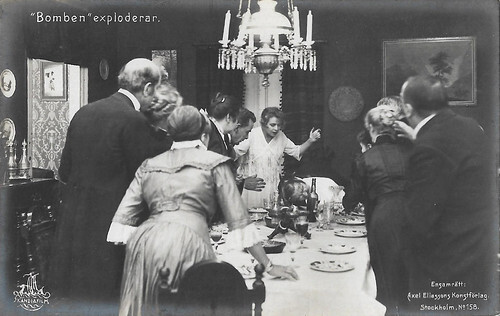
Swedish postcard by Axel Eliassons Konstförlag, Stockholm, no. 158. Photo: Skandia Film. Karin Molander as Elsa and Sam Ask as Bredberg in Bomben (Rune Carlsten, 1920). Caption: The "bomb" has exploded.
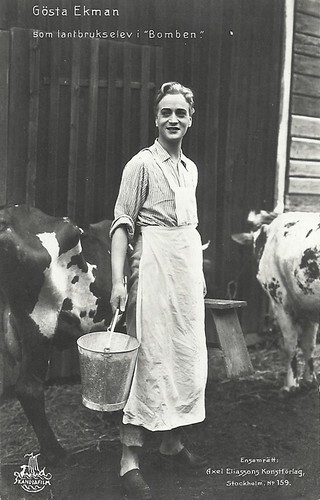
Swedish postcard by Axel Eliassons Konstförlag, Stockholm, no. 159. Photo: Skandia Film. Gösta Ekman in Bomben (Rune Carlsten, 1920). Caption: As farmer apprentice.
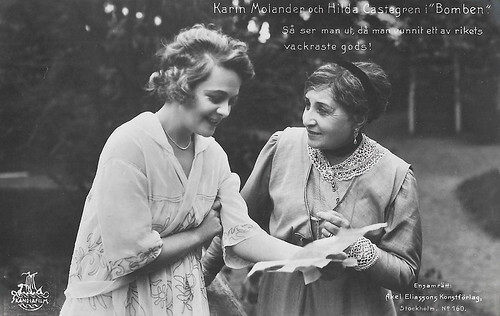
Swedish postcard by Axel Eliassons Konstförlag, Stockholm, no. 160. Photo: Skandia Film. Karin Molander as Elsa Wendel and Hilda Castegren as Mrs. Bredberg, her godmother, in Bomben (Rune Carlsten, 1920). Caption: That's what you look like when you've won one of the most beautiful estates in the kingdom!
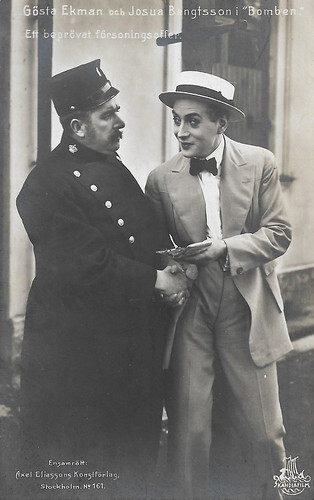
Swedish postcard by Axel Eliassons Konstförlag, Stockholm, no. 161. Photo: Skandia Film. Gösta Ekman as Ture and Josua Bengtsson as Petterson in Bomben (Rune Carlsten, 1920). Caption: A proven sacrifice of reconciliation.
The effects of a drinking tour
Young landlord and agricultural pupil, baron Ture von Örnefeldt ( Gösta Ekman ), celebrates his official day of maturity with a big party at the city hotel in Lillköping. Afterward, he accompanies his new friend, the clerk Lars Morin (Ragnar Arvedson), on a drinking tour, but as Ture in his excitement annoys the city's police, Morin inflicts in order not to lose his reputation.
When Ture later in the night tries to attract Morin's attention by throwing a stone through his window, he thinks the stone killed an elderly gentleman. In fact, the harmful effects have been minimal. The stone accidentally came in through a wrong window and ended up at a birthday party for chief accountant Bredberg from Lillköping (Sam Ask). Bredberg fainted with pure horror, his face going white, causing Ture to think he had murdered the man.
The next day, Bredberg accompanies his goddaughter Elsa Wendel ( Karin Molander ) to the train. Elsa has just received the estate Cronoholm from an uncle, who, however, stipulated in the testament that his heir needs to marry Lt. Gabriel Trane (Vilhelm Bryde), or pay 250,000 Swedish crowns to him. On the same train, Ture is heading away from the neighborhood of his evil.
He meets on the train an old acquaintance from the agricultural school, where he is actually a student. This Josias Svensson (Hugo Tranberg) has been employed as an inspector at Cronoholm and is now about to take up his job. Ture fools his friend to go abroad and wears his inspector's identity. As an inspector of Elsa Werner's estate, Ture becomes in love with his employer, and even she thinks well of him.
However, she sees no opportunity to take on her the expenses of a quarter of a million to avoid marrying the unsympathetic lieutenant Trane. When, furthermore, it fits her to believe that the inspector is bound elsewhere, she decides to announce her engagement with Gabriel Trane. Among the guests at the engagement party, though, there is also chief accountant Bredberg.
Ture finally understands that he is by no means a murderer and therefore he no longer needs to maintain his false identity. The lieutenant's intrigue is revealed, the engagement is broken off, and Elsa and Ture get each other. Since Ture is rich enough to pay the 250,000, the testament is no longer a barrier, and Lieutenant Trane can retreat with sufficient resources to entertain his mistress, actress Bojan Jensen (Lilian Rössel).
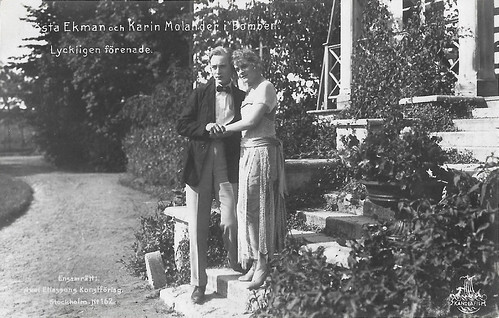
Swedish postcard by Axel Eliassons Konstförlag, Stockholm, no. 162. Photo: Skandia Film. Gösta Ekman and Karin Molander in Bomben (Rune Carlsten, 1920). Caption: Happily united.
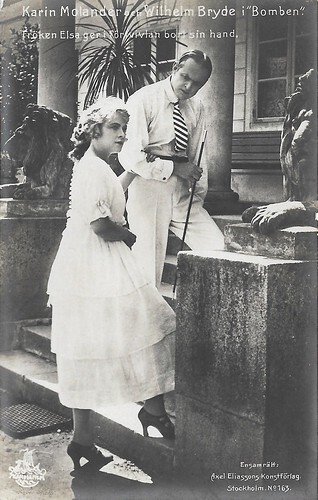
Swedish postcard by Axel Eliassons Konstförlag, Stockholm, no. 163. Photo: Skandia Film. Vilhelm Bryde and Karin Molander in Bomben (Rune Carlsten, 1920). Caption: Miss Elsa gives away her hand in despair.
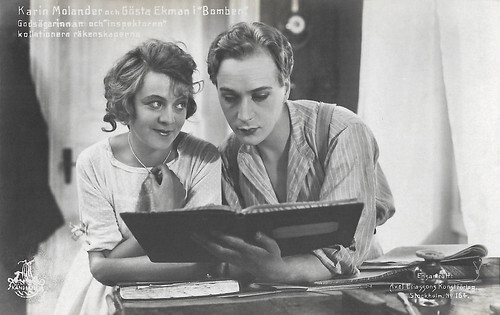
Swedish postcard by Axel Eliassons Konstförlag, Stockholm, no. 164. Photo: Skandia Film. Gösta Ekman and Karin Molander in Bomben (Rune Carlsten, 1920). Caption: The estate manager and the inspector check the accounts.
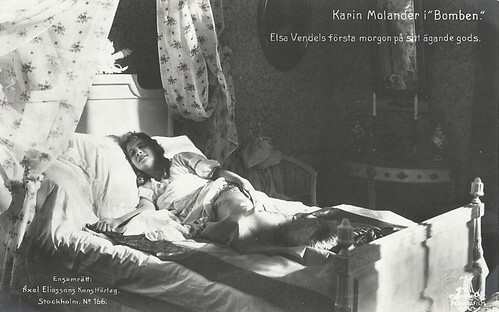
Swedish postcard by Axel Eliassons Konstförlag, Stockholm, no. 166. Photo: Skandia Film. Karin Molander in Bomben (Rune Carlsten, 1920). Caption: Elsa Vendel's first morning amidst her own possessions.
Sources: The Swedish Film Database, Wikipedia (Swedish) and IMDb.

Swedish postcard by Axel Eliassons Konstförlag, Stockholm, no. 158. Photo: Skandia Film. Karin Molander as Elsa and Sam Ask as Bredberg in Bomben (Rune Carlsten, 1920). Caption: The "bomb" has exploded.

Swedish postcard by Axel Eliassons Konstförlag, Stockholm, no. 159. Photo: Skandia Film. Gösta Ekman in Bomben (Rune Carlsten, 1920). Caption: As farmer apprentice.

Swedish postcard by Axel Eliassons Konstförlag, Stockholm, no. 160. Photo: Skandia Film. Karin Molander as Elsa Wendel and Hilda Castegren as Mrs. Bredberg, her godmother, in Bomben (Rune Carlsten, 1920). Caption: That's what you look like when you've won one of the most beautiful estates in the kingdom!

Swedish postcard by Axel Eliassons Konstförlag, Stockholm, no. 161. Photo: Skandia Film. Gösta Ekman as Ture and Josua Bengtsson as Petterson in Bomben (Rune Carlsten, 1920). Caption: A proven sacrifice of reconciliation.
The effects of a drinking tour
Young landlord and agricultural pupil, baron Ture von Örnefeldt ( Gösta Ekman ), celebrates his official day of maturity with a big party at the city hotel in Lillköping. Afterward, he accompanies his new friend, the clerk Lars Morin (Ragnar Arvedson), on a drinking tour, but as Ture in his excitement annoys the city's police, Morin inflicts in order not to lose his reputation.
When Ture later in the night tries to attract Morin's attention by throwing a stone through his window, he thinks the stone killed an elderly gentleman. In fact, the harmful effects have been minimal. The stone accidentally came in through a wrong window and ended up at a birthday party for chief accountant Bredberg from Lillköping (Sam Ask). Bredberg fainted with pure horror, his face going white, causing Ture to think he had murdered the man.
The next day, Bredberg accompanies his goddaughter Elsa Wendel ( Karin Molander ) to the train. Elsa has just received the estate Cronoholm from an uncle, who, however, stipulated in the testament that his heir needs to marry Lt. Gabriel Trane (Vilhelm Bryde), or pay 250,000 Swedish crowns to him. On the same train, Ture is heading away from the neighborhood of his evil.
He meets on the train an old acquaintance from the agricultural school, where he is actually a student. This Josias Svensson (Hugo Tranberg) has been employed as an inspector at Cronoholm and is now about to take up his job. Ture fools his friend to go abroad and wears his inspector's identity. As an inspector of Elsa Werner's estate, Ture becomes in love with his employer, and even she thinks well of him.
However, she sees no opportunity to take on her the expenses of a quarter of a million to avoid marrying the unsympathetic lieutenant Trane. When, furthermore, it fits her to believe that the inspector is bound elsewhere, she decides to announce her engagement with Gabriel Trane. Among the guests at the engagement party, though, there is also chief accountant Bredberg.
Ture finally understands that he is by no means a murderer and therefore he no longer needs to maintain his false identity. The lieutenant's intrigue is revealed, the engagement is broken off, and Elsa and Ture get each other. Since Ture is rich enough to pay the 250,000, the testament is no longer a barrier, and Lieutenant Trane can retreat with sufficient resources to entertain his mistress, actress Bojan Jensen (Lilian Rössel).

Swedish postcard by Axel Eliassons Konstförlag, Stockholm, no. 162. Photo: Skandia Film. Gösta Ekman and Karin Molander in Bomben (Rune Carlsten, 1920). Caption: Happily united.

Swedish postcard by Axel Eliassons Konstförlag, Stockholm, no. 163. Photo: Skandia Film. Vilhelm Bryde and Karin Molander in Bomben (Rune Carlsten, 1920). Caption: Miss Elsa gives away her hand in despair.

Swedish postcard by Axel Eliassons Konstförlag, Stockholm, no. 164. Photo: Skandia Film. Gösta Ekman and Karin Molander in Bomben (Rune Carlsten, 1920). Caption: The estate manager and the inspector check the accounts.

Swedish postcard by Axel Eliassons Konstförlag, Stockholm, no. 166. Photo: Skandia Film. Karin Molander in Bomben (Rune Carlsten, 1920). Caption: Elsa Vendel's first morning amidst her own possessions.
Sources: The Swedish Film Database, Wikipedia (Swedish) and IMDb.
Published on May 10, 2022 22:00
May 9, 2022
Antonio Banderas
Charismatic Spanish film actor, film director, film producer, and singer Antonio Banderas (1960) began his acting career at age 19 with a series of films by director Pedro Almodóvar. He became an internationally known Latin heartthrob with high-profile Hollywood films including Philadelphia (1993), Interview with the Vampire (1994), Desperado (1995), Evita (1996), The Mask of Zorro (1998), and the Shrek sequels. In 2011, the Spanish psychological thriller La piel que habito/The Skin I Live In marked the return of Banderas to Pedro Almodóvar. In this film and in their next film together, Dolor y gloria/Pain and Glory (2019), Banderas gave two of his best performances ever.
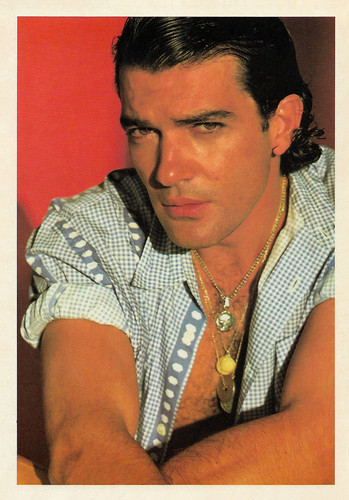
Spanish postcard by Colección 'Estrellas de actualidad' Cacitel, S.L., no. 109, 1990.
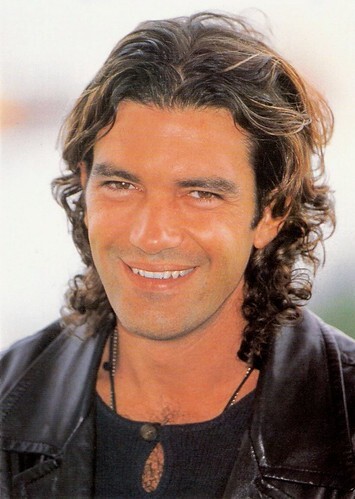
British postcard by Heroes Publishing Ltd, London, no. SPC 2753.
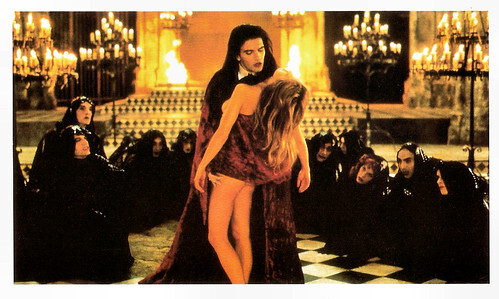
British postcard by Exclusive Collectors' Artcard. Photo: Geffen Pictures. Antonio Banderas in Interview with the Vampire (Neil Jordan, 1994). Caption: Armand (Antonio Banderas) heads the 'Theatre of the Vampires' where human sacrifices provide the nightly entertainment.
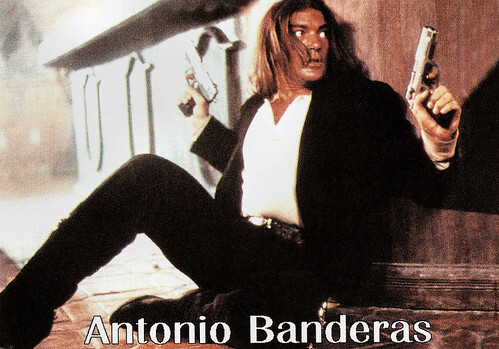
British postcard by Box Office, no. BO 033. Antonio Banderas in Desperado (Roberto Rodriguez, 1995).
Innovative and sexually provocative films
José Antonio Domínguez Banderas was born in Málaga, Spain, in 1960. He was the son of Ana Banderas, a school teacher, and José Domínguez, a police officer in the Guardia Civil. He has one younger brother, Francisco. He took his mother's surname as his stage name.
He initially wanted to be a soccer player, but his dream ended when he broke his foot at age 14. At that time he developed a passion for theatre after seeing the stage production of 'Hair'. Banderas began his acting studies at the School of Dramatic Art in Málaga and made his acting debut at a small theatre in Málaga.
He was arrested by the Spanish police for his performance in a play by Bertolt Brecht, because of the political censorship under the rule of General Francisco Franco. Banderas spent a whole night at the police station. He had three or four of such arrests while he was working with a small theatre troupe that toured all over Spain and was giving performances in small-town theatres and on the street.
In 1981, at the age of 19, he moved to Madrid in pursuit of an acting career. There he joined the troupe at the National Theatre of Spain, becoming the youngest member of the company. Banderas' stage performances caught the attention of film director Pedro Almodóvar, who cast the young actor in Pestañas postizas (Enrique Belloch, 1982), produced by Almodóvar.
Banderas and Almodovar joined forces in making innovative and sexually provocative films during the 1980s. He played a gay Islamic terrorist in Laberinto de pasiones/Labyrinth of Passion (Pedro Almodóvar, 1982). In Matador (Pedro Almodóvar, 1986), he played a troubled young man who is confused about his sexuality. Banderas made headlines in Spain with his performance as a psychotic gay stalker, making his first male-to-male on-screen kiss in Almodovar's La ley del deseo/Law of Desire (1987, Pedro Almodóvar) with Carmen Maura.
Banderas's long and fruitful collaboration with Almodóvar eventually prepared him for international recognition that came with his work in the Academy Award-nominated film Mujeres al borde de un ataque de nervios/Women on the Verge of a Nervous Breakdown (Pedro Almodóvar, 1988). He had his breakthrough with the controversial ¡Átame!/Tie Me Up! Tie Me Down! (Pedro Almodóvar, 1989) as mental patient Ricky, who kidnaps a porn star (Victoria Abril) and keeps her tied up until she returns his love.
Other Spanish films in which he appeared were El señor Galíndez (Rodolfo Kuhn, 1984) starring Héctor Alterio, Los zancos/The Stilts (Carlos Saura, 1984) with Laura del Sol and Fernando Fernán Gómez, Si te dicen que caí/If They Tell You I Fell (Vicente Aranda, 1989) with Victoria Abril, and Terra Nova (Calogero Salvo, 1991).
In 1991 he got also international attention as an unwitting object of Madonna 's affection in the documentary Madonna: Truth or Dare (Alek Keshishian, Mark Aldo Miceli, 1991).
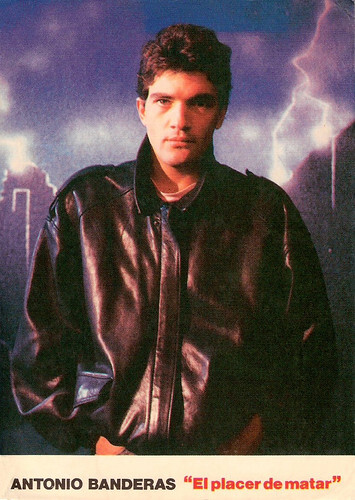
Spanish postcard by Novo Graf for Lauren Films. Photo: publicity still for El placer de matar (Félix Rotaeta, 1988).
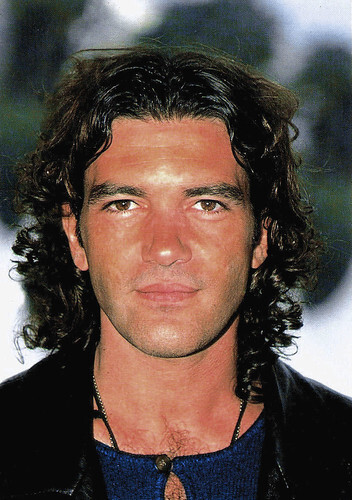
Italian postcard by Edibas, no. 582. Photo: Olympia.
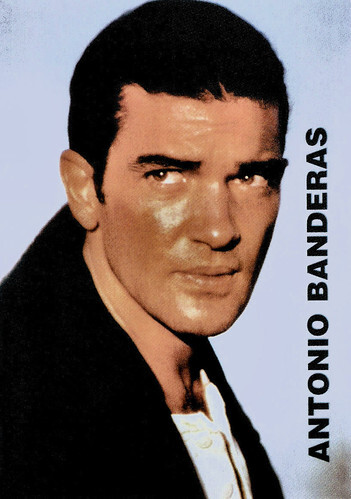
British postcard by Underground, no. BO 115.
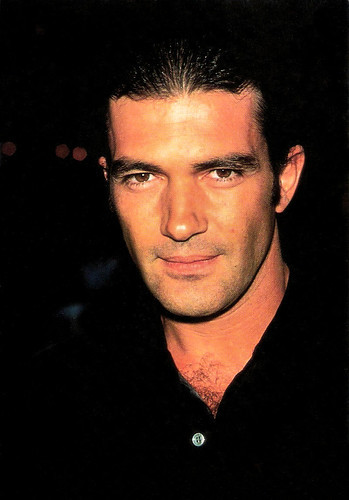
Italian postcard in the World Collection by Edibas s.r.l., Torino, no. P.c. 716. Photo: Olympia.
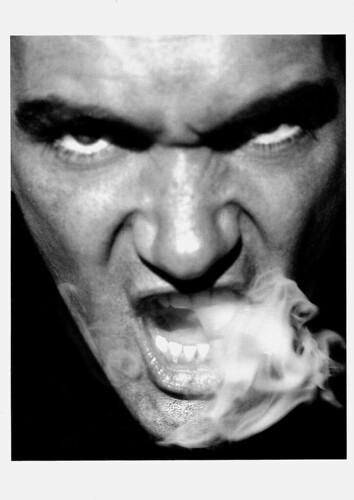
American postcard by Fotofolio. Photo: Herb Ritts, 1994.
A shimmering gunslinger
In 1992 Antonio Banderas made his Hollywood debut with The Mambo Kings (Arne Glimcher, 1992) as a soulful Cuban trumpeter opposite Armand Assante. Because he did not speak English at that time, his dialogue for the film was taught to him phonetically. At AllMovie, Rebecca Flint Marx writes: “Banderas still managed to turn in a critically praised performance as a struggling musician.”
He then shot to international fame with his sensitive performance as the lover of Tom Hanks' AIDS-infected lawyer in Philadelphia (Jonathan Demme, 1993).
During the following years, he appeared in several major Hollywood releases. He played a substantial role as a sexy European vampire opposite Tom Cruise and Brad Pitt in the film adaptation of Anne Rice’s Interview with the Vampire: The Vampire Chronicles (Neil Jordan, 1994).
Banderas had a box office hit with his starring role as the shimmering gunslinger El Mariachi in Desperado (Roberto Rodriguez, 1995). He starred as ubiquitous narrator Che alongside Madonna as Eva Peron in Evita (Alan Parker, 1996), an adaptation of the musical by Andrew Lloyd Webber and Tim Rice.
He had another box office success with his role as the legendary masked swordsman Zorro in The Mask of Zorro (1998, Martin Campbell), opposite Anthony Hopkins and Catherina Zeta-Jones . Banderas was the first Latino to play the Mexican swashbuckler.
Banderas' debut as a director was the interesting black comedy Crazy in Alabama (1999), starring his wife Melanie Griffith. In 2000, Ridley Scott offered Banderas a part as a peasant in his film, Gladiator (Ridley Scott, 2000) and he reluctantly accepted but demanded $50,000 for the role - currently the world record for the highest salary of an extra.
In 2001, he collaborated again with Robert Rodriguez who cast him in the Spy Kids films. He also starred in the poor Original Sin (Michael Cristofer, 2001) with Angelina Jolie. In 2002, he starred in the equally poor Femme Fatale (Brian De Palma, 2002) opposite Rebecca Romijn-Stamos and in Frida (2002, Julie Taymor) with Salma Hayek.
He reprised his role as El Mariachi in the last installment of Robert Rodriguez' Mexico trilogy Once Upon A Time In Mexico (Roberto Rodriguez, 2003) with Johnny Depp and Salma Hayek.
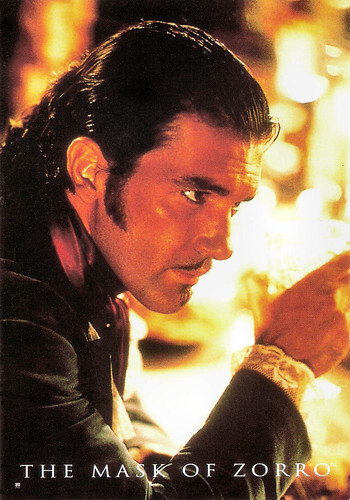
French postcard by Sonis, no. C. 899. Photo: Zorro Productions / Tristar Pictures. Publicity still for The Mask of Zorro (Martin Campbell, 1998).
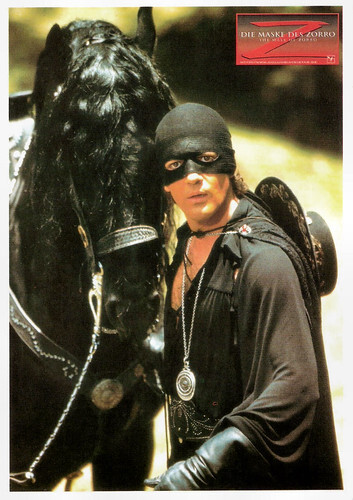
German postcard by Memory Cards, no. 497. Photo: publicity still for The Mask of Zorro (Martin Campbell, 1998).
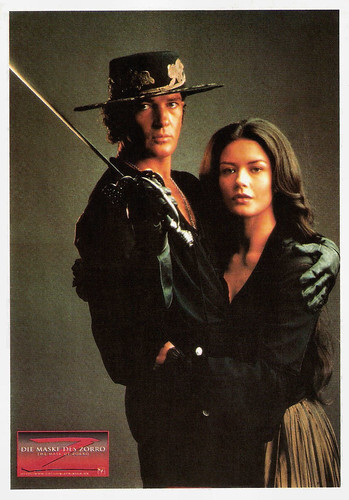
German postcard by Memory Cards, no. 495. Photo: publicity still for The Mask of Zorro (Martin Campbell, 1998), with Catherina Zeta-Jones .
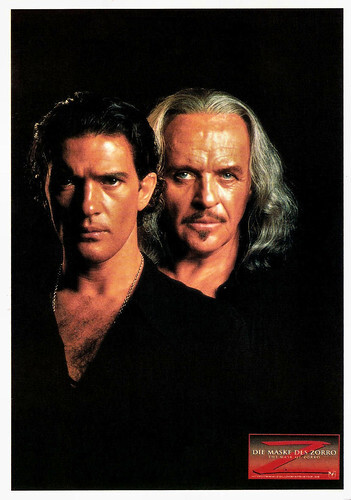
German postcard by Memory Cards, no. 496. Photo: publicity still for The Mask of Zorro (Martin Campbell, 1998), with Anthony Hopkins.
A sexy, macho swashbuckler
In 2003, Antonio Banderas returned to the musical genre, appearing to great acclaim in the Broadway revival of Maury Yeston's musical Nine, based on the film 8½, playing the prime role originated by the late Raúl Juliá. Banderas won both the Outer Critics Circle and Drama Desk awards and was nominated for the Tony Award for best actor in a musical.
Tweaking his image as a sexy, macho swashbuckler, Banderas next provided the pitch-perfect voice of the rapier-wielding Puss-in-Boots for Shrek 2 (Andrew Adamson, Kelly Asbury, Conrad Verno, 2004), Shrek the Third (Chris Miller, Raman Hui, 2007) and the last film in the Shrek franchise, Shrek Forever After (Mike Mitchell, 2010). The character became so popular on the family film circuit, that it became the protagonist of the spin-off film Puss in Boots: The Story of an Ogre Killer (Mike Mitchell, 2011).
In 2005, Banderas reprised his role as Zorro in The Legend of Zorro (Martin Campbell, 2005), though this was not as successful as the original. A year later, he starred in Take the Lead (Liz Friedlander, 2006), a high school-set movie in which he played a ballroom dancing teacher.
In 2010 he starred in the Woody Allen comedy You Will Meet a Tall Dark Stranger (Woody Allen, 2010). It was followed by Spy Kids 4: All the Time in the World (Robert Rodriguez, 2011).
In 2011 Banderas reteamed for the first time in two decades with Pedro Almodóvar in the Hitchcock-inspired La piel que habito/The Skin I Live In. Perry Seibert at AllMovie: "Luckily, Banderas continues to bring out Almodovar's most-outrageous impulses. You won't hear anyone coming out of this movie muttering, 'we've seen that story before.' But in a way, if you've kept up with Almodovar over the last three decades, you really have seen much of this movie before. Sure, the actual plot points are new, but the themes are quintessential Almodovar. His obsession with cross-dressing finds its seemingly natural conclusion in this film, and he continues to show how most men are slaves to their sexual desires, while most women are forever at the mercy of these unstable men."
The next year he appeared as a mysterious international espionage figure in the action thriller Haywire (Steven Soderbergh, 2012). Then, he appeared in a small role in Rodriguez's Machete Kills (Robert Rodriguez, 2013) and he joined Sylvester Stallone and his merry band of senior action heroes in The Expendables 3 (Patrick Hughes, 2014).
In 2019, Banderas had a new career highlight in the Spanish film Dolor y gloria/Pain and Glory (Pedro Almodóvar, 2019), which centers around an aging film director, played by Banderas who is suffering from chronic illness and writer's block as he reflects on his life in flashbacks to his childhood. The film has been described as semi-autobiographical, according to Almodóvar. Banderas won the Cannes Film Festival Award for Best Actor and was nominated for his first-ever Academy Award for Best Actor in a Leading Role for the film.
Banderas then starred in the Netflix film, The Laundromat (Steven Soderbergh, 2019) alongside Meryl Streep, and Gary Oldman, and in the fantasy adventure film Dolittle (2020) alongside Robert Downey Jr. In 2023, he will appear in the upcoming fifth Indiana Jones film with Harrison Ford , Mads Mikkelsen, and Toby Jones. He will reprise his voice role as Puss in Boots in the sequel Puss in Boots: The Last Wish.
Antonio Banderas divorced his first wife, actress Ana Leza in 1996, and married Melanie Griffith that same year. They had met a year earlier while shooting the romantic comedy Two Much (Fernando Trueba, 1995). Their romance on the set helped the film set box-office records in Spain. In June 2014 Griffith and Banderas announced their separation after a marriage of 18 years. They have a daughter, Stella Banderas (1996). Despite being divorced Banderas and Griffith remain on strong terms, remaining friends.
TCM : "Handsome, charismatic, and undeniably talented, Banderas rightfully earned his place as one of cinema's greatest leading men." Antonio Banderas shares time between his two residencies, one in the United States and one in the South of Spain. He has invested his movie earnings in Andalusian products and owns 50% of a winery in Northern Spain called Anta Banderas which makes red and rose wines.
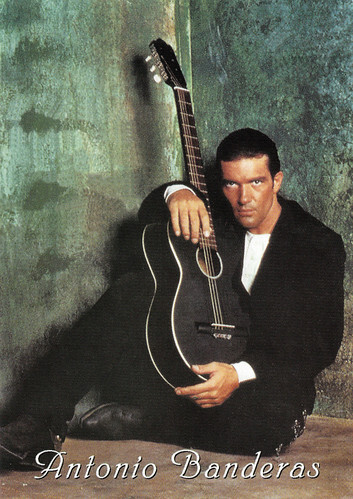
British postcard by Box Office, no. BO 085. Antonio Banderas in Desperado (Roberto Rodriguez, 1995).
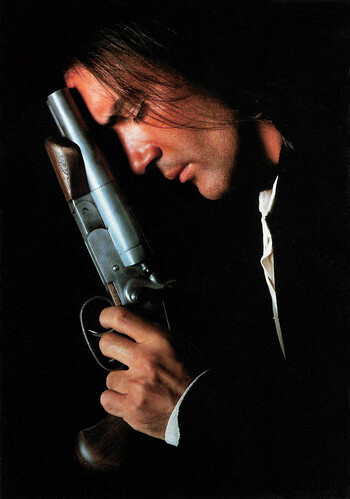
British postcard. Antonio Banderas in Desperado (Roberto Rodriguez, 1995). Caption: He came back to settle the score with someone. Anyone. EVERYONE.
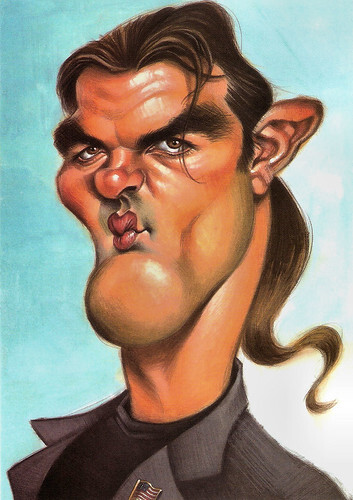
Spanish postcard by Karikaturas, Ref. BDR 03. Image: Vizcarra / El Jueves.

Taiwanese postcard by Cool Card. Image: film poster of Antonio Banderas and Catherine Zeta-Jones in The Legend of Zorro (Martin Campbell, 2005).
Official Trailer ¡Átame!/Tie Me Up! Tie Me Down! (Pedro Almodóvar, 1989). Source: Rialto Film Entertainment (YouTube).
Official trailer La piel que habito/The Skin I Live In (Pedro Almodóvar, 2011). Source: Streaming Trailers (YouTube).
Sources: Rebecca Flint Marx (AllMovie), (IMDb), Perry Seibert (AllMovie), Lizzie Smith (Daily Mail), TCM, Wikipedia, and .

Spanish postcard by Colección 'Estrellas de actualidad' Cacitel, S.L., no. 109, 1990.

British postcard by Heroes Publishing Ltd, London, no. SPC 2753.

British postcard by Exclusive Collectors' Artcard. Photo: Geffen Pictures. Antonio Banderas in Interview with the Vampire (Neil Jordan, 1994). Caption: Armand (Antonio Banderas) heads the 'Theatre of the Vampires' where human sacrifices provide the nightly entertainment.

British postcard by Box Office, no. BO 033. Antonio Banderas in Desperado (Roberto Rodriguez, 1995).
Innovative and sexually provocative films
José Antonio Domínguez Banderas was born in Málaga, Spain, in 1960. He was the son of Ana Banderas, a school teacher, and José Domínguez, a police officer in the Guardia Civil. He has one younger brother, Francisco. He took his mother's surname as his stage name.
He initially wanted to be a soccer player, but his dream ended when he broke his foot at age 14. At that time he developed a passion for theatre after seeing the stage production of 'Hair'. Banderas began his acting studies at the School of Dramatic Art in Málaga and made his acting debut at a small theatre in Málaga.
He was arrested by the Spanish police for his performance in a play by Bertolt Brecht, because of the political censorship under the rule of General Francisco Franco. Banderas spent a whole night at the police station. He had three or four of such arrests while he was working with a small theatre troupe that toured all over Spain and was giving performances in small-town theatres and on the street.
In 1981, at the age of 19, he moved to Madrid in pursuit of an acting career. There he joined the troupe at the National Theatre of Spain, becoming the youngest member of the company. Banderas' stage performances caught the attention of film director Pedro Almodóvar, who cast the young actor in Pestañas postizas (Enrique Belloch, 1982), produced by Almodóvar.
Banderas and Almodovar joined forces in making innovative and sexually provocative films during the 1980s. He played a gay Islamic terrorist in Laberinto de pasiones/Labyrinth of Passion (Pedro Almodóvar, 1982). In Matador (Pedro Almodóvar, 1986), he played a troubled young man who is confused about his sexuality. Banderas made headlines in Spain with his performance as a psychotic gay stalker, making his first male-to-male on-screen kiss in Almodovar's La ley del deseo/Law of Desire (1987, Pedro Almodóvar) with Carmen Maura.
Banderas's long and fruitful collaboration with Almodóvar eventually prepared him for international recognition that came with his work in the Academy Award-nominated film Mujeres al borde de un ataque de nervios/Women on the Verge of a Nervous Breakdown (Pedro Almodóvar, 1988). He had his breakthrough with the controversial ¡Átame!/Tie Me Up! Tie Me Down! (Pedro Almodóvar, 1989) as mental patient Ricky, who kidnaps a porn star (Victoria Abril) and keeps her tied up until she returns his love.
Other Spanish films in which he appeared were El señor Galíndez (Rodolfo Kuhn, 1984) starring Héctor Alterio, Los zancos/The Stilts (Carlos Saura, 1984) with Laura del Sol and Fernando Fernán Gómez, Si te dicen que caí/If They Tell You I Fell (Vicente Aranda, 1989) with Victoria Abril, and Terra Nova (Calogero Salvo, 1991).
In 1991 he got also international attention as an unwitting object of Madonna 's affection in the documentary Madonna: Truth or Dare (Alek Keshishian, Mark Aldo Miceli, 1991).

Spanish postcard by Novo Graf for Lauren Films. Photo: publicity still for El placer de matar (Félix Rotaeta, 1988).

Italian postcard by Edibas, no. 582. Photo: Olympia.

British postcard by Underground, no. BO 115.

Italian postcard in the World Collection by Edibas s.r.l., Torino, no. P.c. 716. Photo: Olympia.

American postcard by Fotofolio. Photo: Herb Ritts, 1994.
A shimmering gunslinger
In 1992 Antonio Banderas made his Hollywood debut with The Mambo Kings (Arne Glimcher, 1992) as a soulful Cuban trumpeter opposite Armand Assante. Because he did not speak English at that time, his dialogue for the film was taught to him phonetically. At AllMovie, Rebecca Flint Marx writes: “Banderas still managed to turn in a critically praised performance as a struggling musician.”
He then shot to international fame with his sensitive performance as the lover of Tom Hanks' AIDS-infected lawyer in Philadelphia (Jonathan Demme, 1993).
During the following years, he appeared in several major Hollywood releases. He played a substantial role as a sexy European vampire opposite Tom Cruise and Brad Pitt in the film adaptation of Anne Rice’s Interview with the Vampire: The Vampire Chronicles (Neil Jordan, 1994).
Banderas had a box office hit with his starring role as the shimmering gunslinger El Mariachi in Desperado (Roberto Rodriguez, 1995). He starred as ubiquitous narrator Che alongside Madonna as Eva Peron in Evita (Alan Parker, 1996), an adaptation of the musical by Andrew Lloyd Webber and Tim Rice.
He had another box office success with his role as the legendary masked swordsman Zorro in The Mask of Zorro (1998, Martin Campbell), opposite Anthony Hopkins and Catherina Zeta-Jones . Banderas was the first Latino to play the Mexican swashbuckler.
Banderas' debut as a director was the interesting black comedy Crazy in Alabama (1999), starring his wife Melanie Griffith. In 2000, Ridley Scott offered Banderas a part as a peasant in his film, Gladiator (Ridley Scott, 2000) and he reluctantly accepted but demanded $50,000 for the role - currently the world record for the highest salary of an extra.
In 2001, he collaborated again with Robert Rodriguez who cast him in the Spy Kids films. He also starred in the poor Original Sin (Michael Cristofer, 2001) with Angelina Jolie. In 2002, he starred in the equally poor Femme Fatale (Brian De Palma, 2002) opposite Rebecca Romijn-Stamos and in Frida (2002, Julie Taymor) with Salma Hayek.
He reprised his role as El Mariachi in the last installment of Robert Rodriguez' Mexico trilogy Once Upon A Time In Mexico (Roberto Rodriguez, 2003) with Johnny Depp and Salma Hayek.

French postcard by Sonis, no. C. 899. Photo: Zorro Productions / Tristar Pictures. Publicity still for The Mask of Zorro (Martin Campbell, 1998).

German postcard by Memory Cards, no. 497. Photo: publicity still for The Mask of Zorro (Martin Campbell, 1998).

German postcard by Memory Cards, no. 495. Photo: publicity still for The Mask of Zorro (Martin Campbell, 1998), with Catherina Zeta-Jones .

German postcard by Memory Cards, no. 496. Photo: publicity still for The Mask of Zorro (Martin Campbell, 1998), with Anthony Hopkins.
A sexy, macho swashbuckler
In 2003, Antonio Banderas returned to the musical genre, appearing to great acclaim in the Broadway revival of Maury Yeston's musical Nine, based on the film 8½, playing the prime role originated by the late Raúl Juliá. Banderas won both the Outer Critics Circle and Drama Desk awards and was nominated for the Tony Award for best actor in a musical.
Tweaking his image as a sexy, macho swashbuckler, Banderas next provided the pitch-perfect voice of the rapier-wielding Puss-in-Boots for Shrek 2 (Andrew Adamson, Kelly Asbury, Conrad Verno, 2004), Shrek the Third (Chris Miller, Raman Hui, 2007) and the last film in the Shrek franchise, Shrek Forever After (Mike Mitchell, 2010). The character became so popular on the family film circuit, that it became the protagonist of the spin-off film Puss in Boots: The Story of an Ogre Killer (Mike Mitchell, 2011).
In 2005, Banderas reprised his role as Zorro in The Legend of Zorro (Martin Campbell, 2005), though this was not as successful as the original. A year later, he starred in Take the Lead (Liz Friedlander, 2006), a high school-set movie in which he played a ballroom dancing teacher.
In 2010 he starred in the Woody Allen comedy You Will Meet a Tall Dark Stranger (Woody Allen, 2010). It was followed by Spy Kids 4: All the Time in the World (Robert Rodriguez, 2011).
In 2011 Banderas reteamed for the first time in two decades with Pedro Almodóvar in the Hitchcock-inspired La piel que habito/The Skin I Live In. Perry Seibert at AllMovie: "Luckily, Banderas continues to bring out Almodovar's most-outrageous impulses. You won't hear anyone coming out of this movie muttering, 'we've seen that story before.' But in a way, if you've kept up with Almodovar over the last three decades, you really have seen much of this movie before. Sure, the actual plot points are new, but the themes are quintessential Almodovar. His obsession with cross-dressing finds its seemingly natural conclusion in this film, and he continues to show how most men are slaves to their sexual desires, while most women are forever at the mercy of these unstable men."
The next year he appeared as a mysterious international espionage figure in the action thriller Haywire (Steven Soderbergh, 2012). Then, he appeared in a small role in Rodriguez's Machete Kills (Robert Rodriguez, 2013) and he joined Sylvester Stallone and his merry band of senior action heroes in The Expendables 3 (Patrick Hughes, 2014).
In 2019, Banderas had a new career highlight in the Spanish film Dolor y gloria/Pain and Glory (Pedro Almodóvar, 2019), which centers around an aging film director, played by Banderas who is suffering from chronic illness and writer's block as he reflects on his life in flashbacks to his childhood. The film has been described as semi-autobiographical, according to Almodóvar. Banderas won the Cannes Film Festival Award for Best Actor and was nominated for his first-ever Academy Award for Best Actor in a Leading Role for the film.
Banderas then starred in the Netflix film, The Laundromat (Steven Soderbergh, 2019) alongside Meryl Streep, and Gary Oldman, and in the fantasy adventure film Dolittle (2020) alongside Robert Downey Jr. In 2023, he will appear in the upcoming fifth Indiana Jones film with Harrison Ford , Mads Mikkelsen, and Toby Jones. He will reprise his voice role as Puss in Boots in the sequel Puss in Boots: The Last Wish.
Antonio Banderas divorced his first wife, actress Ana Leza in 1996, and married Melanie Griffith that same year. They had met a year earlier while shooting the romantic comedy Two Much (Fernando Trueba, 1995). Their romance on the set helped the film set box-office records in Spain. In June 2014 Griffith and Banderas announced their separation after a marriage of 18 years. They have a daughter, Stella Banderas (1996). Despite being divorced Banderas and Griffith remain on strong terms, remaining friends.
TCM : "Handsome, charismatic, and undeniably talented, Banderas rightfully earned his place as one of cinema's greatest leading men." Antonio Banderas shares time between his two residencies, one in the United States and one in the South of Spain. He has invested his movie earnings in Andalusian products and owns 50% of a winery in Northern Spain called Anta Banderas which makes red and rose wines.

British postcard by Box Office, no. BO 085. Antonio Banderas in Desperado (Roberto Rodriguez, 1995).

British postcard. Antonio Banderas in Desperado (Roberto Rodriguez, 1995). Caption: He came back to settle the score with someone. Anyone. EVERYONE.

Spanish postcard by Karikaturas, Ref. BDR 03. Image: Vizcarra / El Jueves.

Taiwanese postcard by Cool Card. Image: film poster of Antonio Banderas and Catherine Zeta-Jones in The Legend of Zorro (Martin Campbell, 2005).
Official Trailer ¡Átame!/Tie Me Up! Tie Me Down! (Pedro Almodóvar, 1989). Source: Rialto Film Entertainment (YouTube).
Official trailer La piel que habito/The Skin I Live In (Pedro Almodóvar, 2011). Source: Streaming Trailers (YouTube).
Sources: Rebecca Flint Marx (AllMovie), (IMDb), Perry Seibert (AllMovie), Lizzie Smith (Daily Mail), TCM, Wikipedia, and .
Published on May 09, 2022 22:00
Paul van Yperen's Blog
- Paul van Yperen's profile
- 13 followers
Paul van Yperen isn't a Goodreads Author
(yet),
but they
do have a blog,
so here are some recent posts imported from
their feed.



